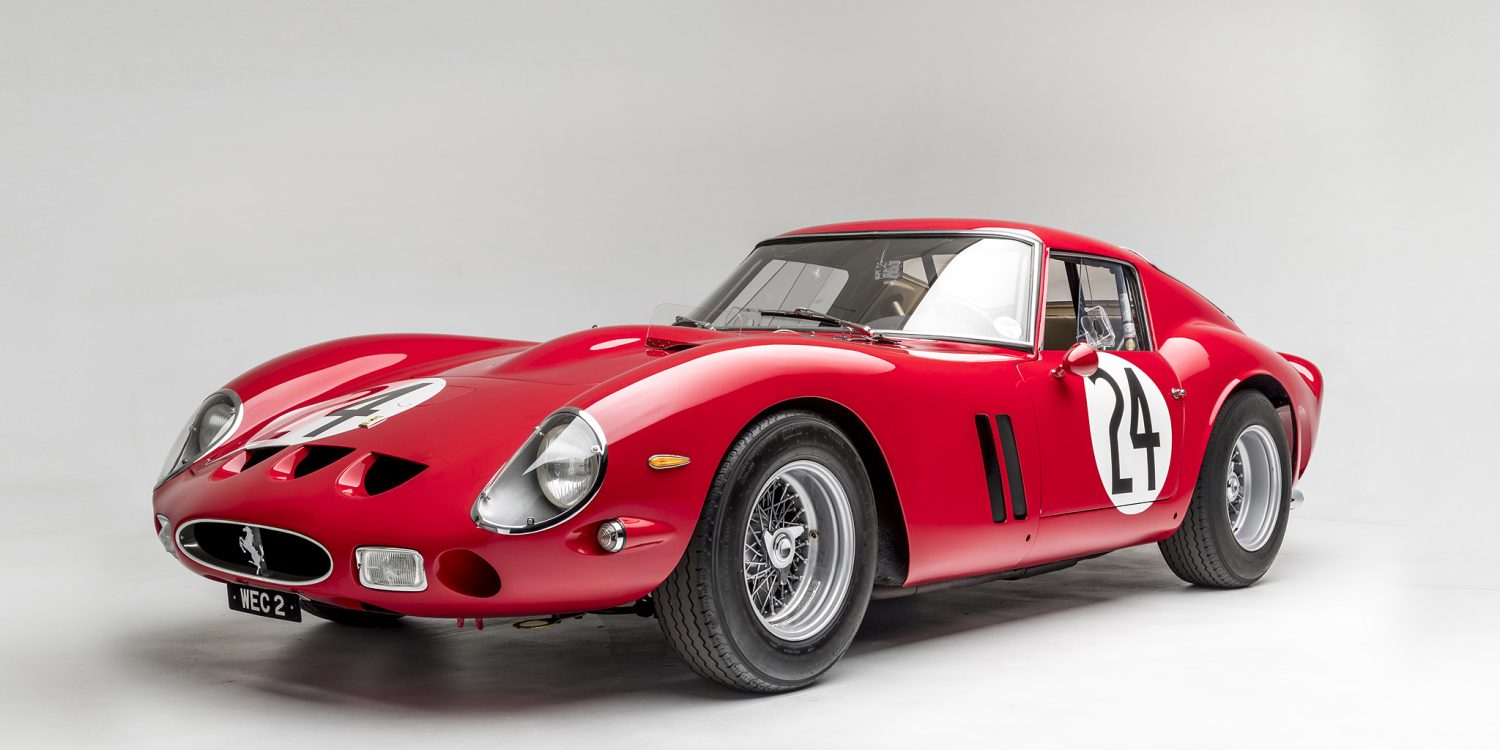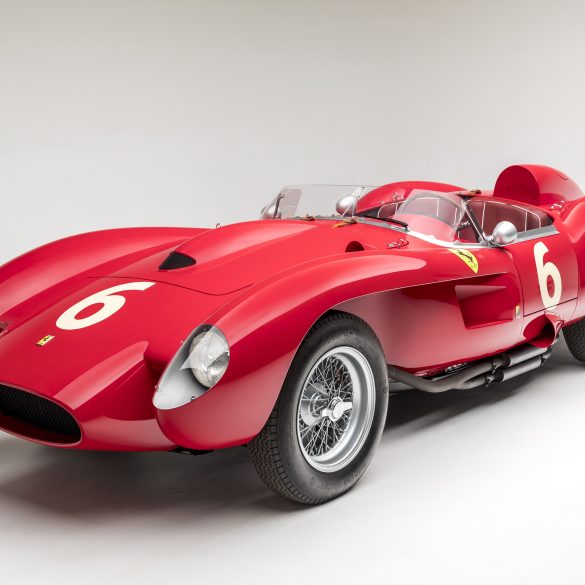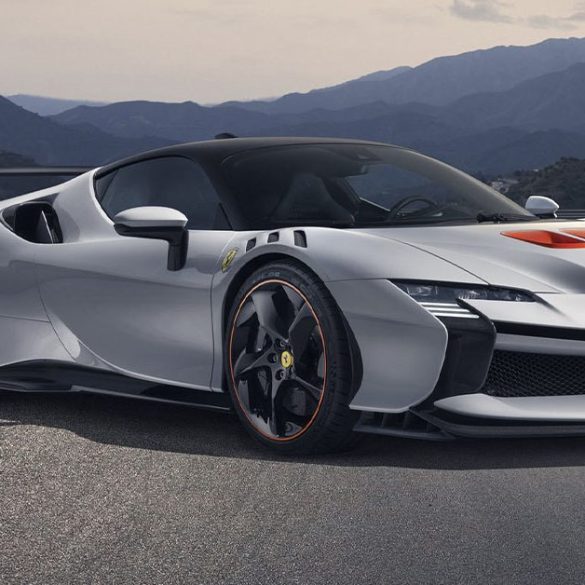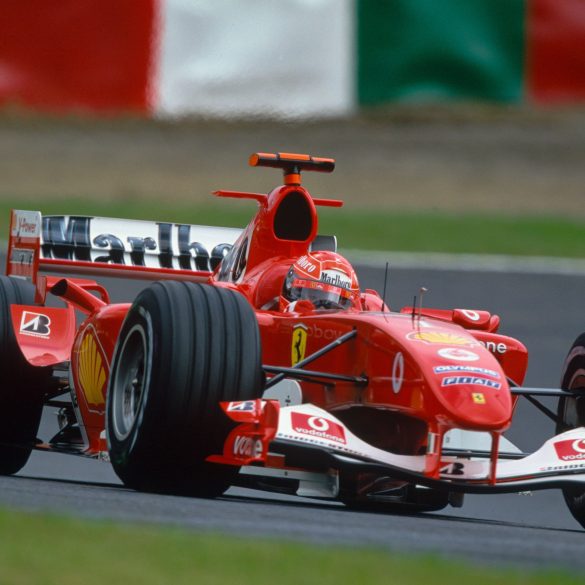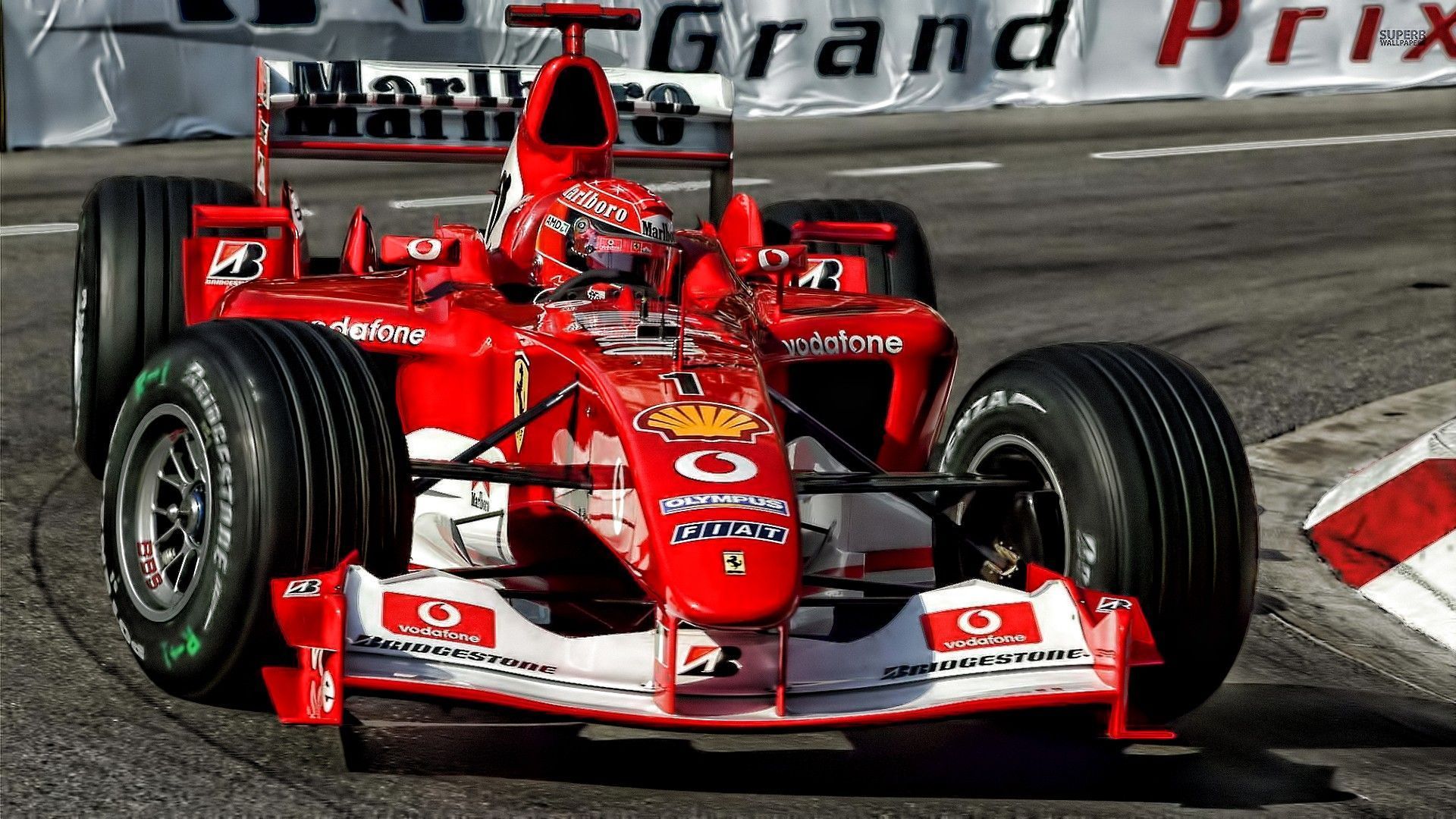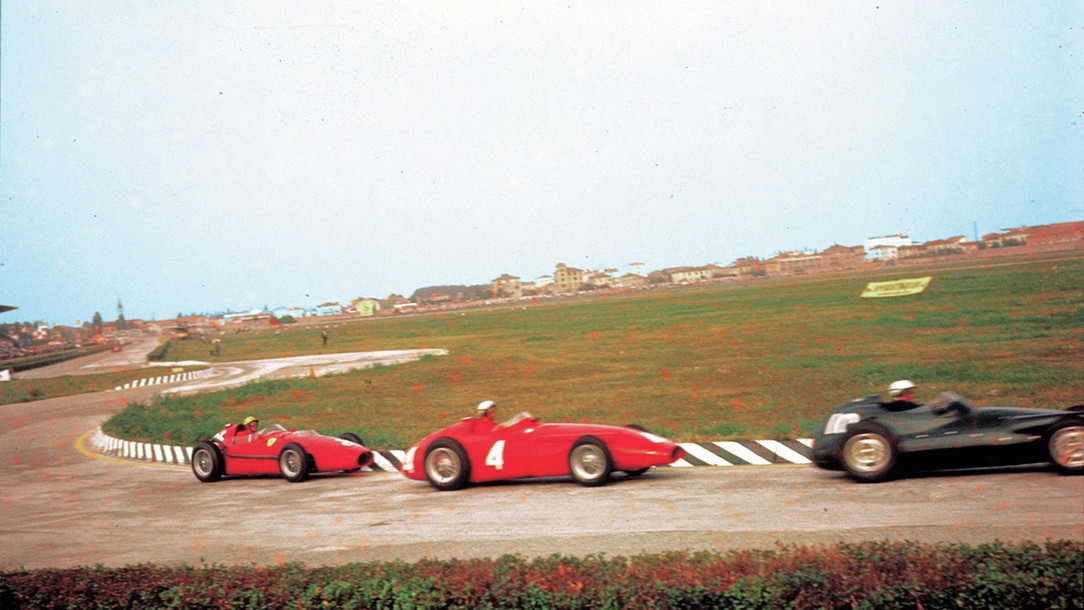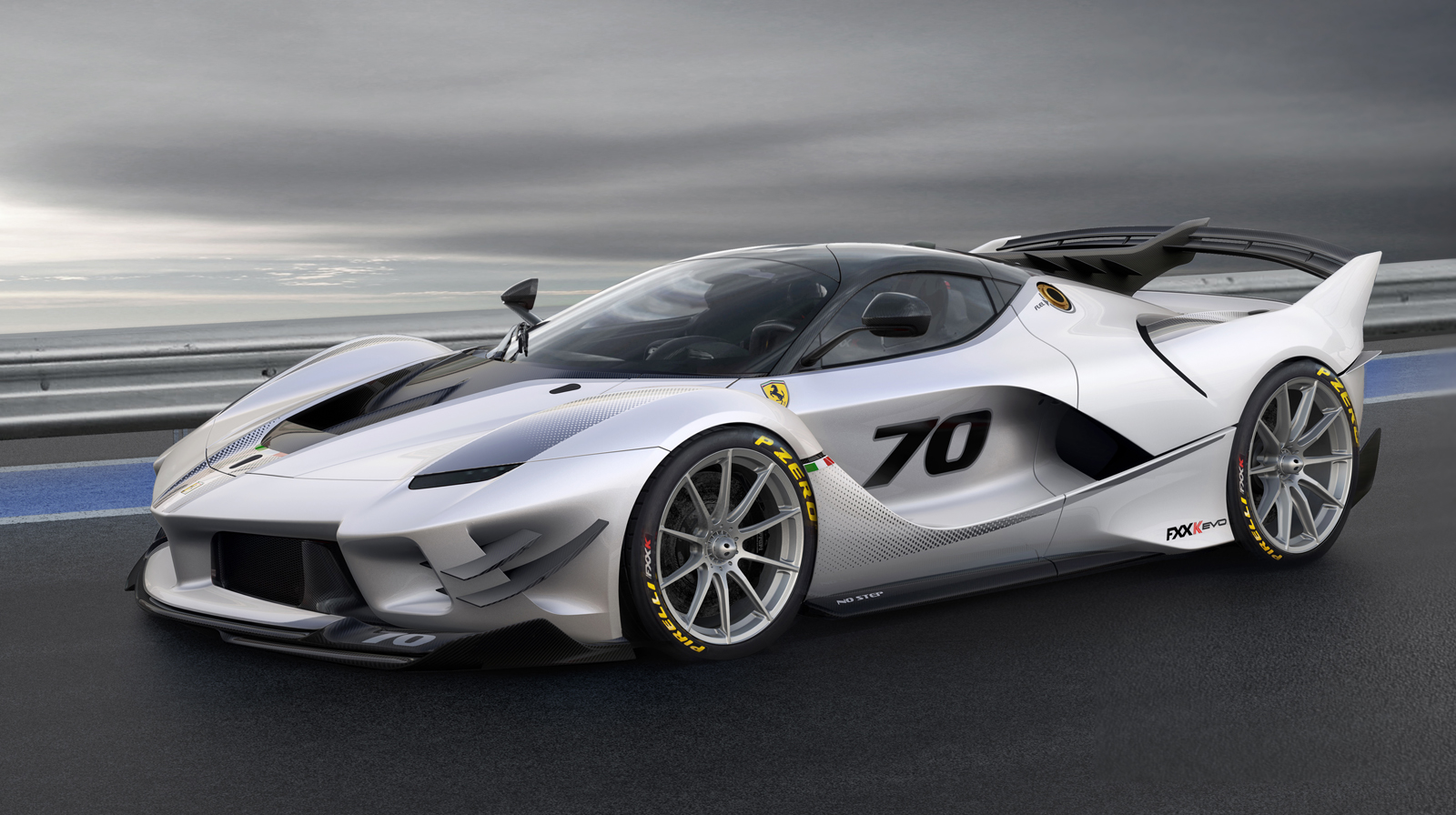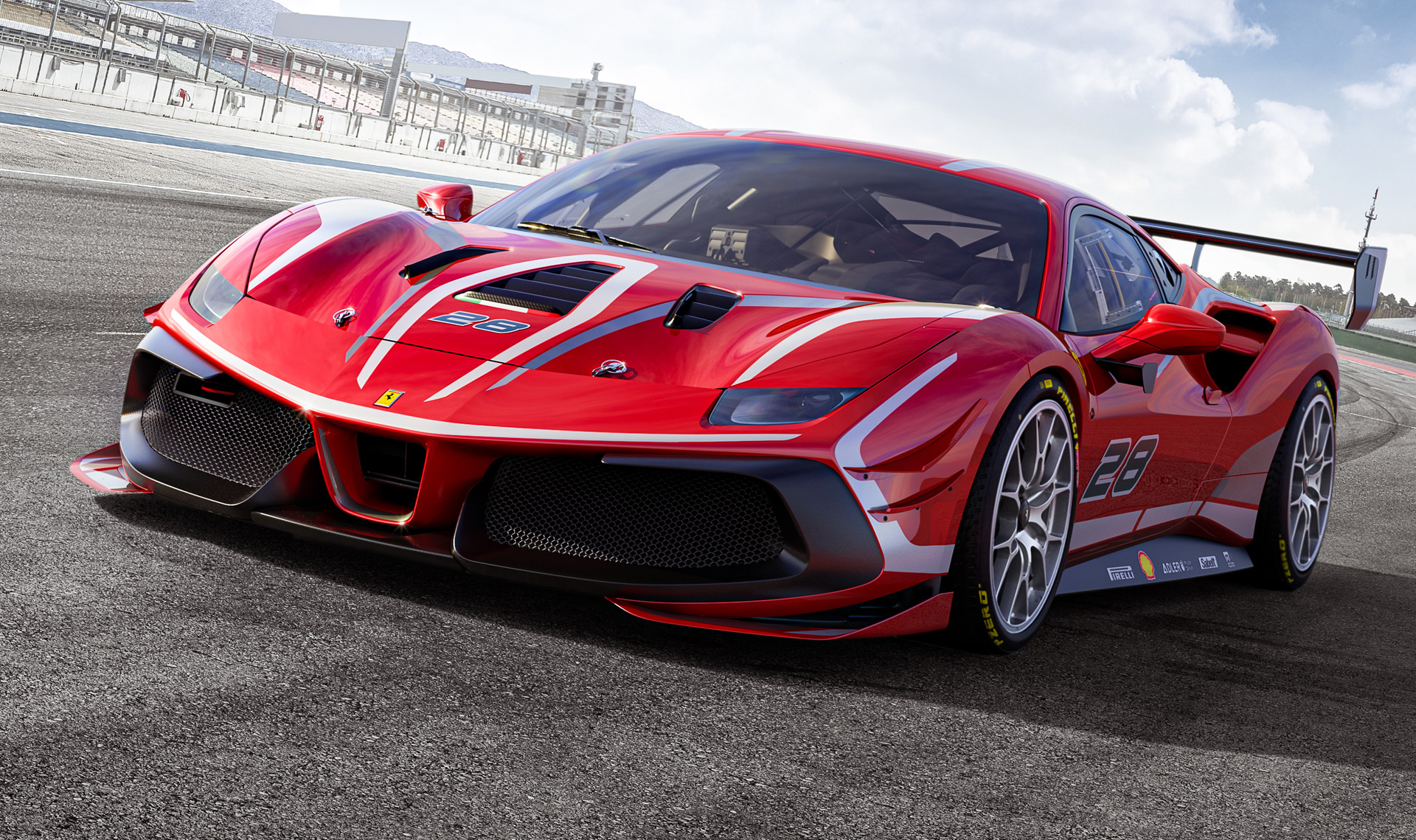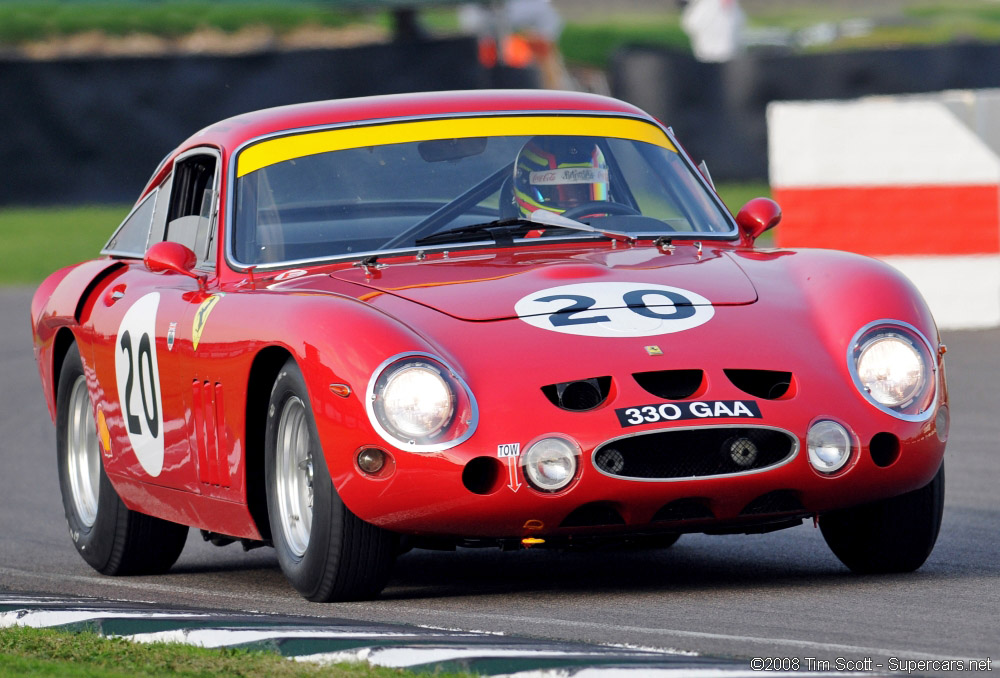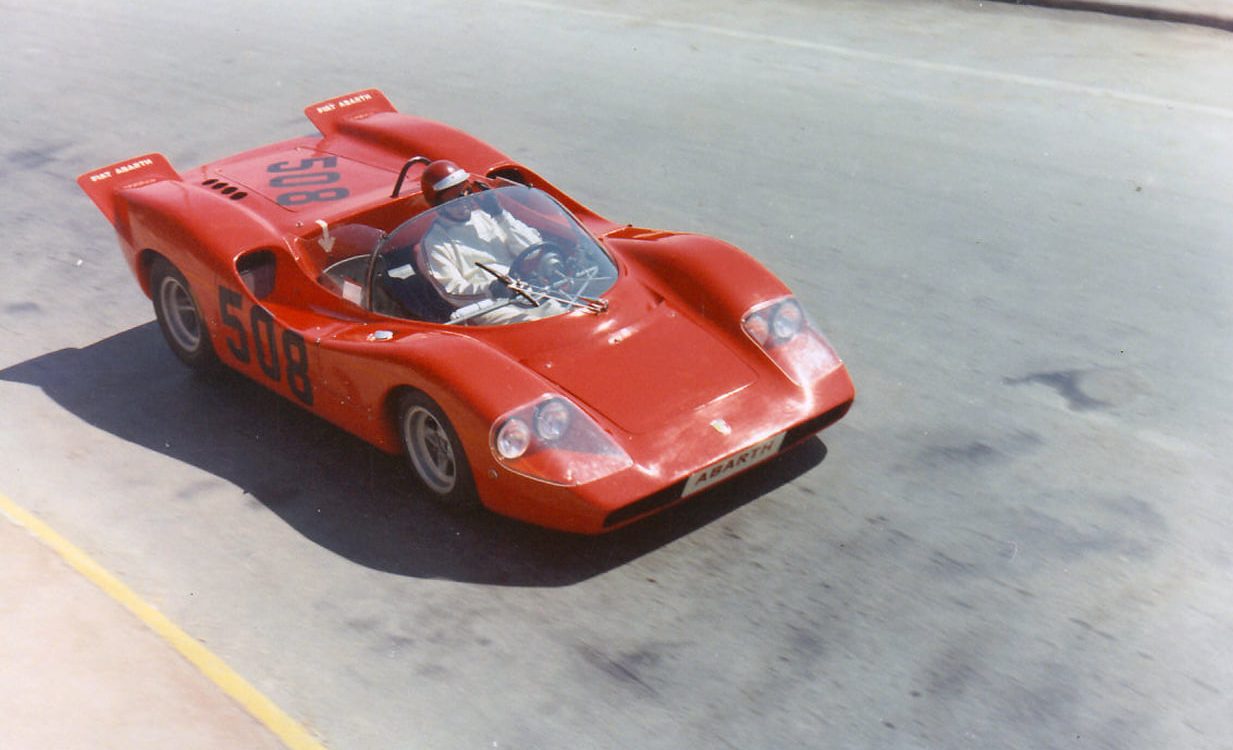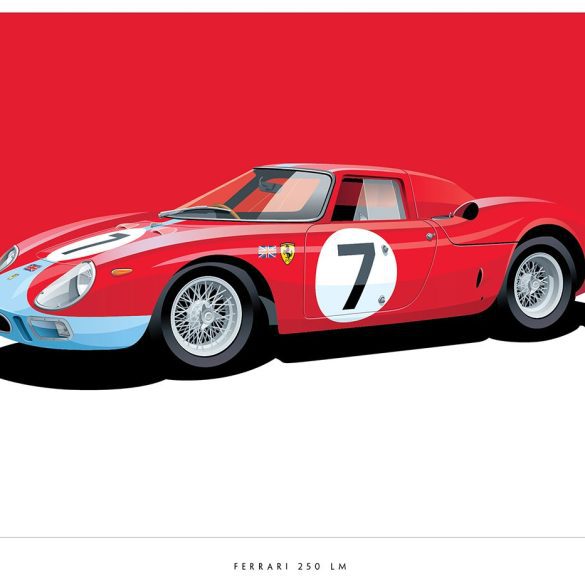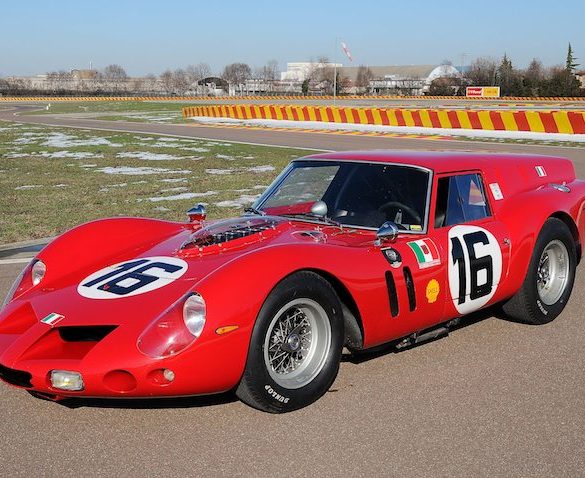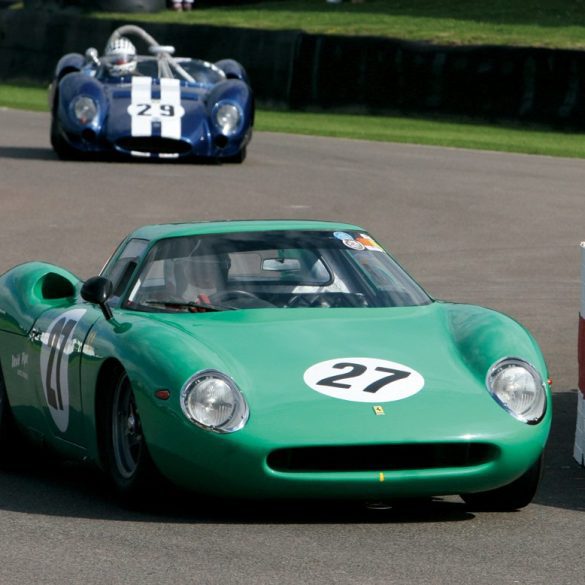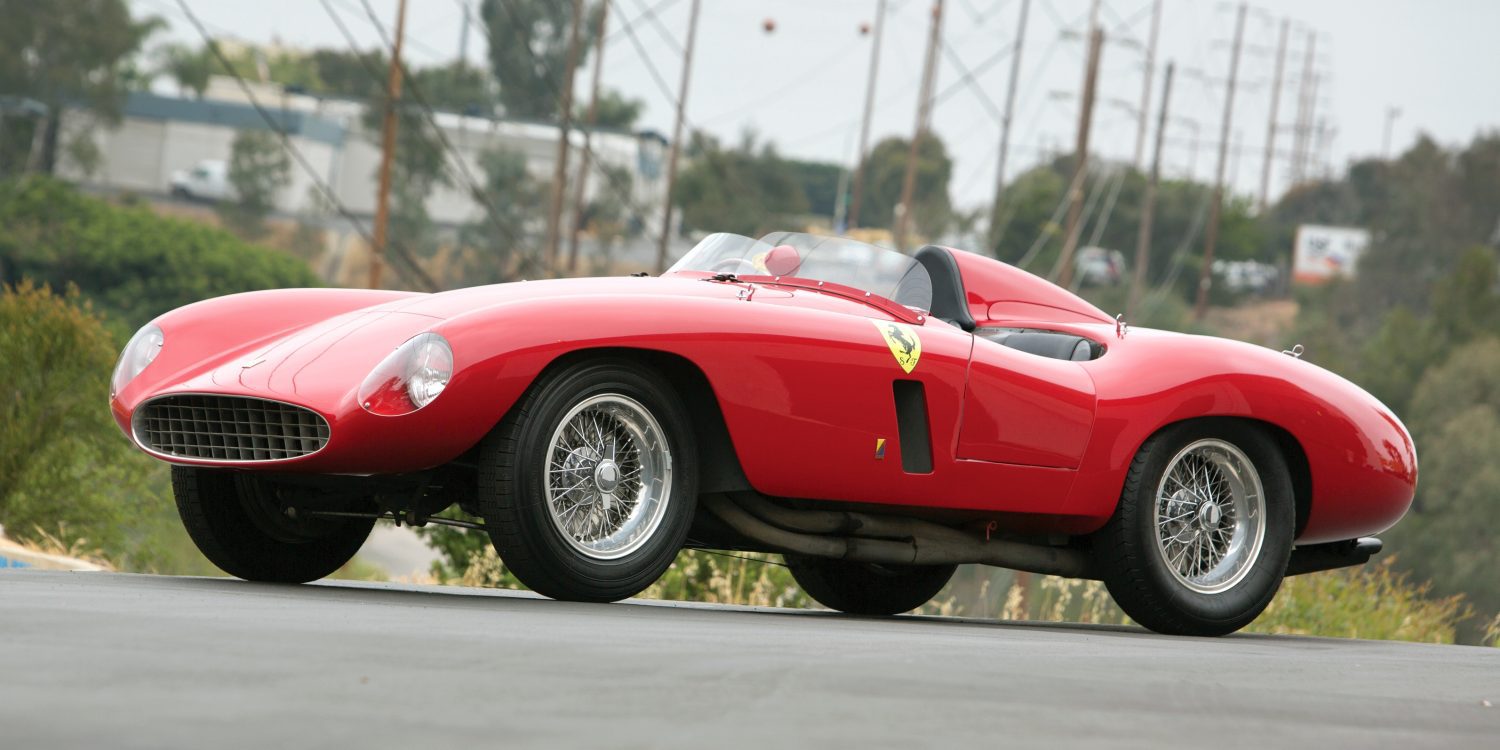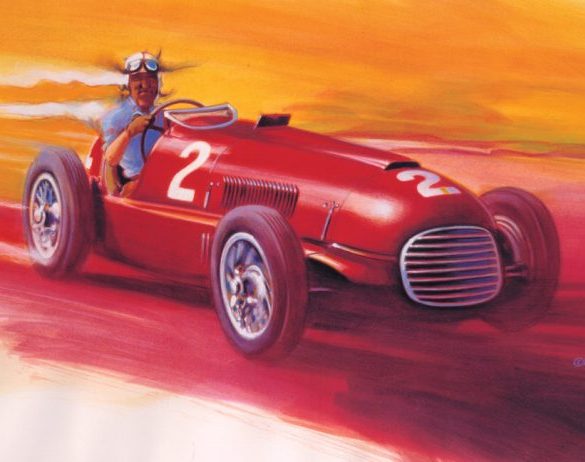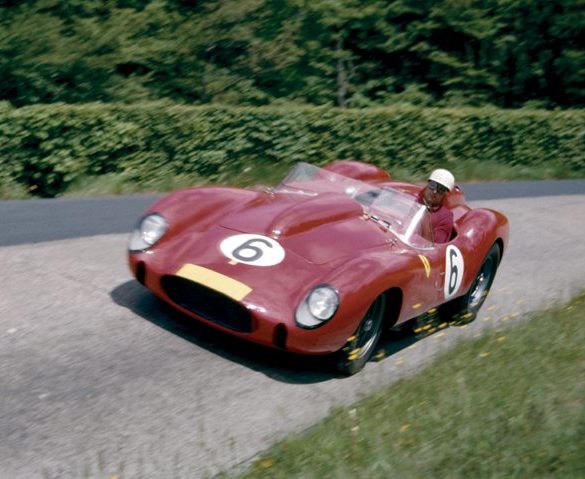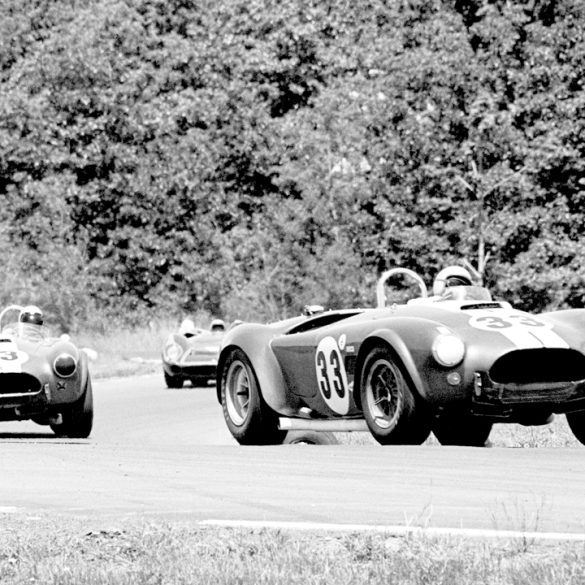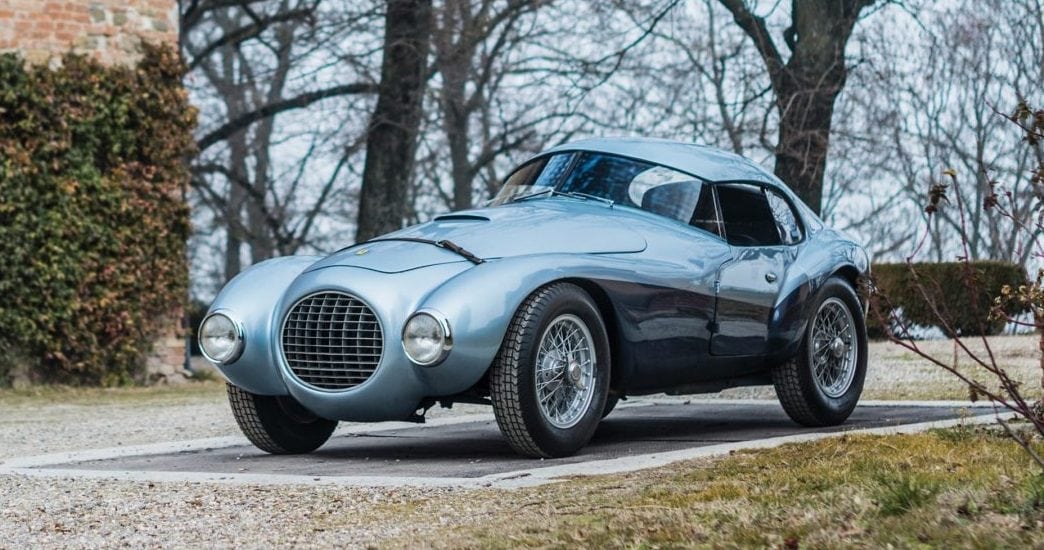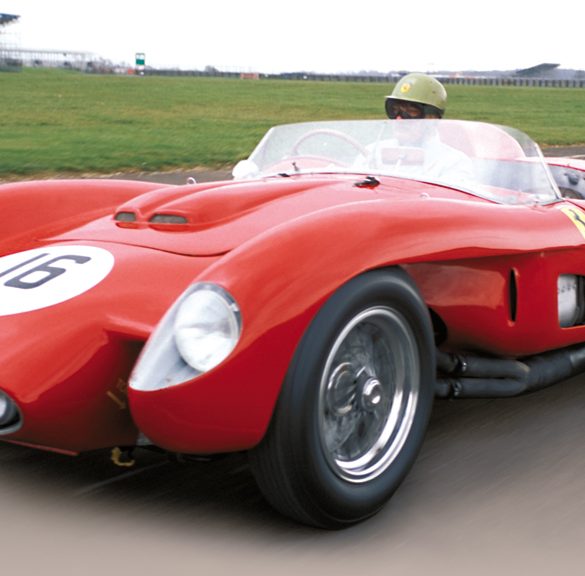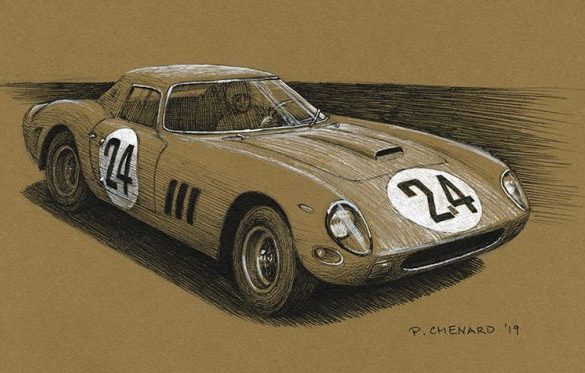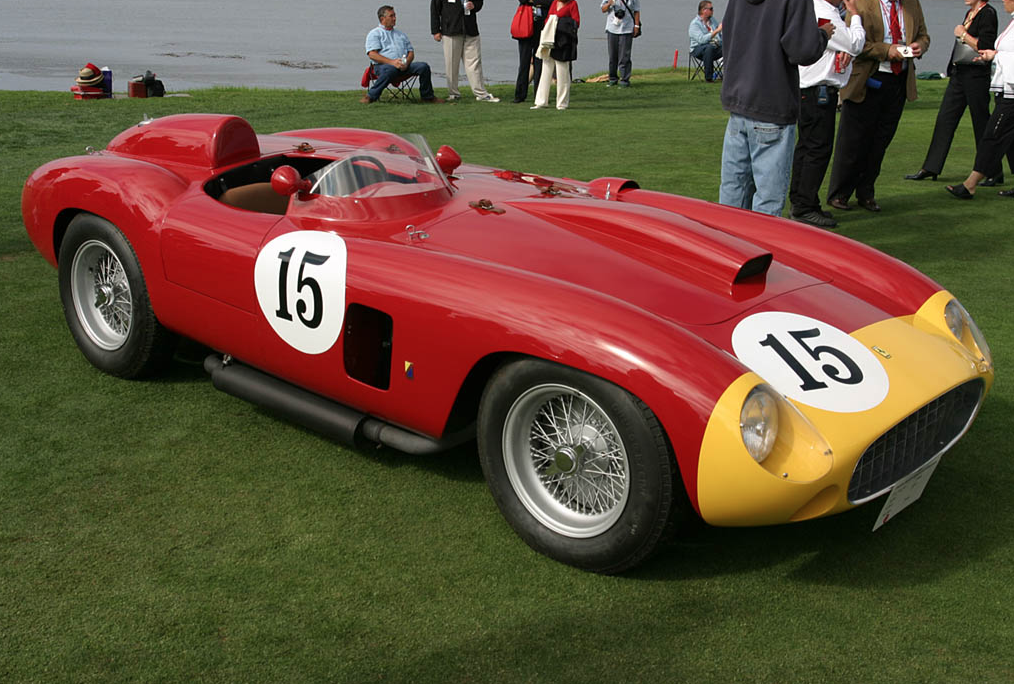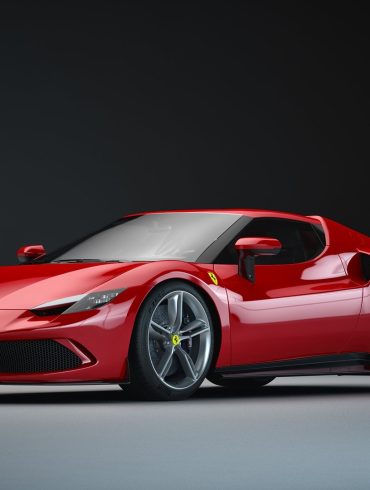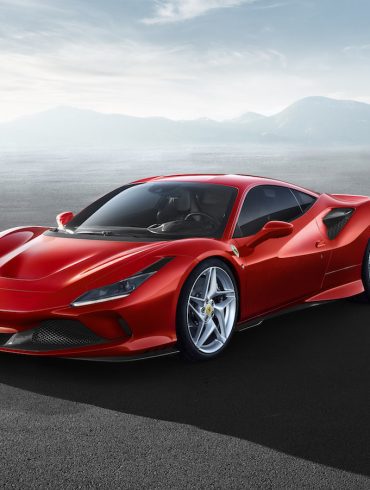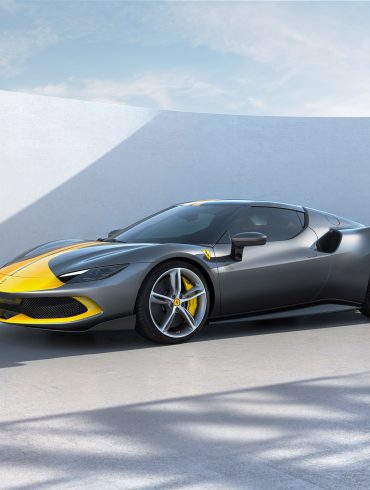Ferrari Race Cars
Ferrari Racing & Competition Models. 200+ Race Cars.
Ferrari. The very name evokes images of speed, glamour, and unparalleled success in the world of motorsports. For over 75 years, the Cavallino Rampante has graced some of the most iconic and dominant racing machines ever conceived. From the original dusty circuits of Formula One to the grueling endurance tests of Le Mans, Ferrari's relentless pursuit of victory has forged a legacy unlike any other. This is our guide to every race car made by Ferrari.
Formula One / Formula 2 / XX & Specials / Challenge / Sports Cars & GTs
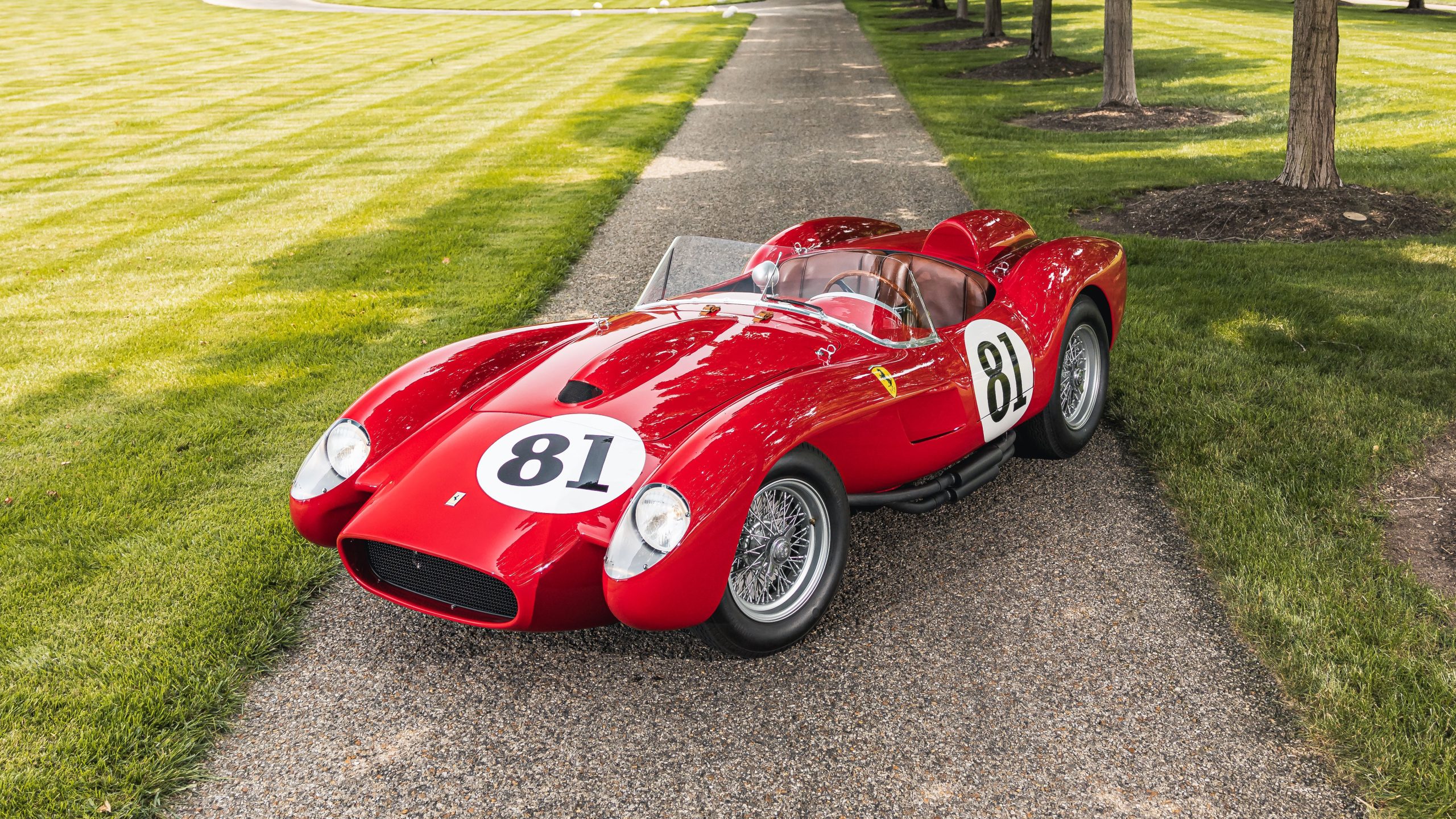
Every Ferrari Race Car Ever Made
Enzo Ferrari wanted to race. He had no interest in the idea of producing road cars. When he initially started Ferrari it was built to prepare, and successfully race, various drivers in Alfa Romeo. That was until 1938, when he was hired by Alfa Romeo to head their motor racing department. In 1929, Enzo Ferrari left Alfa Romeo's employment to start his own racing stable (scuderia in Italian). Scuderia Ferrari did not race cars with the Ferrari name, though the Alfas they used on the track did sport the prancing horse. Race cars came to the Scuderia from Alfa for tuning for almost a decade, and the Ferrari shop in Modena built its first car, the Alfa Romeo 158 Grand Prix racer, in 1937. In 1938, Alfa took its racing program in-house, and Enzo Ferrari went with it. After 10 years on his own, though, working for someone else proved difficult. He left Alfa (or was dismissed) for the last time in 1939.
When Enzo Ferrari left Alfa Romeo, he agreed to not use his name in connection with racing for four years. That wasn't so bad; WWII curtailed racing for most of those four years anyway. Ferrari moved from Modena to Maranello during the war. In 1945, Ferrari began work on the 12-cylinder engine the company would be famous for, and in 1947, Enzo Ferrari drove the first 125 S out of the factory gates. Post-war racing was Ferrari's finest hour on the track. During the 1950s, Ferrari had legendary engineers like Lampredi and Jano on the payroll, and bodies designed by the legendary Pinin Farina. Every time a race car was improved, the road car was the beneficiary. In 1951, a Ferrari 375 brought the team its first victory -- over Alfa Romeo, no less. The '60s started out pretty good for Ferrari: Phil Hill won the Formula 1 championship in 1961 using a 1.5-liter V6 race car nicknamed "Dino." It was the era of the sexy, swooping 250 Testa Rossa. But things got rough for the Prancing Horse, like when Carroll Shelby brought his Cobra to European race tracks. In the 1990s things looked good for Ferrari in Formula One. The hot-blooded Ferrari cars met their match in the cool German driving of Michael Schumacher, who raced Ferraris to seven F1 championships between 1994 and 2004.
You can see that Ferrari is passionate about racing like no other team on the planet. This page is dedicated to those race cars, to the Formula One, GT and Sports Prototypes that are the true Ferrari cars that made the company successful. We spent months putting this list together, so we hope you enjoy it.
Ferrari Formula 1 Cars
Scuderia Ferrari S.p.A. is the oldest, most recognizable and famous Formula One team. The team was founded by Enzo Ferrari, initially to race cars produced by Alfa Romeo, though by 1947 Ferrari had begun building its own cars. The results are staggering, with Ferrari having won a record 16 Constructors' Championships and 15 Driver's Championships. Over 200 victories and almost 800 pole positions tell only part of the story of this team. While drivers like Michael Schumacher and Sebastian Vettel get all the attention, we want to focus on the cars, the Ferrari F1 machines that made it all possible.
Ferrari 125 F1 (1948 - 1952)
Ferrari 275 F1 (1950 - 1952)
Ferrari 340 F1 (1950)
Ferrari 375 F1 (1950 - 1952)
Ferrari 212 F1 (1951)
Ferrari 553 F1 (1953)
Ferrari 625 F1 (1954 - 1956)
Ferrari 555 F1 (1954)
Ferrari-Lancia D50 (1955)
Ferrari 801 F1 (1957)
Ferrari 246 F1 (1958 - 1960)
Ferrari 256 F1 (1959)
Ferrari 246 P F1 (1960)
Ferrari 156 F1 (1961 - 1964)
Ferrari 158 F1 (1964 - 1965)
Ferrari 512 F1 (1512) (1964 - 1965)
Ferrari 246 F1-66 (1966)
Ferrari 312 F1 (1966 - 1969)
Ferrari 312 B (1970)
Ferrari 312 B2 (1971 -1973)
Ferrari 312 B3 (1973 - 1974)
Ferrari 312 T (1975 - 1976)
Ferrari 312 T2 (1976 - 1978)
Ferrari 312 T3 (1978 - 1979)
Ferrari 312 T4 (1979)
Ferrari 312 T5 (1980)
Ferrari 126 C (1981)
Ferrari 126 C2 (1982 - 1983)
Ferrari 126 C3 (1983)
Ferrari 126 C4 (1984)
Ferrari 156/85 (1985)
Ferrari F1-86 (1986)
Ferrari F1-87 (1987)
Ferrari F1-87/88C (1988)
Ferrari 640 F1-89 (1989)
Ferrari 641 F1-90 (1990)
Ferrari 642 F1-91 (1991)
Ferrari 643 F1-92 (1991)
Ferrari F92A (1992)
Ferrari F93A (1993)
Ferrari 412 T1 (1994)
Ferrari 412 T2 (1995)
Ferrari F310 (1996)
Ferrari F310B (1997)
Ferrari F300 (1998)
Ferrari F399 (1999)
Ferrari F1-2000 (2000)
Ferrari F2001 (2001 - 2002)
Ferrari F2002 (2002 - 2003)
Ferrari F2003-GA (2003 - 2004)
Ferrari F2004 (2004)
Ferrari F2005 (2005)
Ferrari 248 F1 (2006)
Ferrari F2007 (2007)
Ferrari F2008 (2008)
Ferrari F60 (2009)
Ferrari F10 (2010)
Ferrari 150° Italia (2011)
Ferrari F2012 (2012)
Ferrari F138 (2013)
Ferrari F14 T (2014)
Ferrari SF15-T (2015)
Ferrari SF16-H (2016)
Ferrari SF70H (2017)
Ferrari SF71H (2018)
Ferrari SF90 (2019)
Ferrari SF1000 (2020)
Ferrari SF21 (2021)
Ferrari F1-75 (2022)
Ferrari SF-23 (2023)
Ferrari SF-24 (2024)
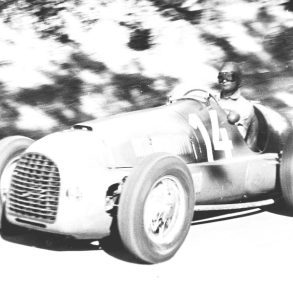
Ferrari 125 F1
Season: 1948 - 1952
The 125 F1 was Ferrari's first Formula One car. It shared its engine with the 125 S sports racer which preceded it by a year. The 125 F1 used a supercharged 1.5-litre V12 engine. Used during the 1950 and 1951 seasons in a total of 8 Grand Prix (used in Grands Prix in 1948 and 1949).
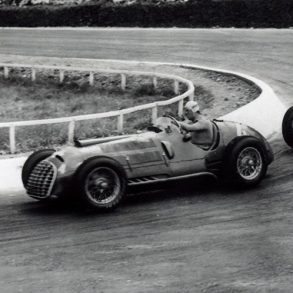
Ferrari 275 F1
Season: 1950 - 1952
After finding only modest success with the supercharged 125 F1 car in Formula One, Ferrari decided to switch for 1950 to the naturally aspirated 4.5 L formula for the series. The 275 was replaced at the Grand Prix of Nations at Geneva on July 30, 1950 by the 340 F1.
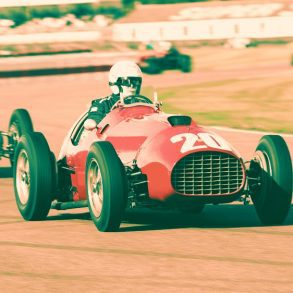
Ferrari 340 F1
Season: 1950
The 275 engine grew to become a 340 thanks to the increase in cylinder capacity from the original 3322 cc to the 4101cc. The car was used in a non-championship race which is why the 340 does not appear in the official list of Ferrari F1 cars. Widely used for sports and GT cars.
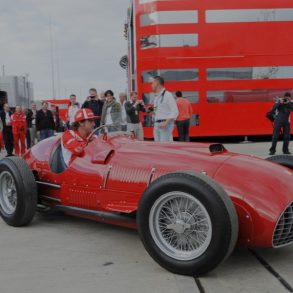
Ferrari 375 F1
Season: 1950 - 1952
The new 4.5-litre, 375 F1 was not ready until the Italian Grand Prix in September. The Lampredi-engined cars featured a steel tubular frame constructed around two large diameter side members. With three Grand Prix wins, the 375 F1 was Ferrari's first successful Formula 1 car.
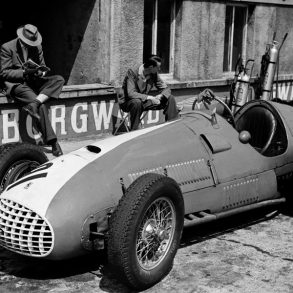
Ferrari 212 F1
Season: 1951
With a small 2562 cc engine and only 200 hp this was an interesting car. Two versions were built, one with a De Dion rear axle, and one with oscillating half-axles and used in various races in 1951. It was allowed it to be used in special races, such as uphill races, a Swiss speciality.
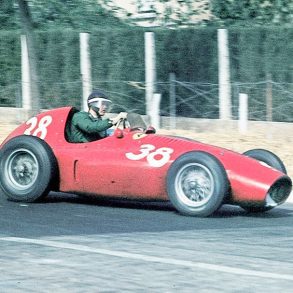
Ferrari 553 F1
Season: 1953 - 1954
The car competed in six World Championship Grands Prix over the two seasons, making ten individual entries. Its only points finishing position was a win for Mike Hawthorn at the 1954 Spanish Grand Prix. It was an alternative to the 625 model, with the short stroke engine.
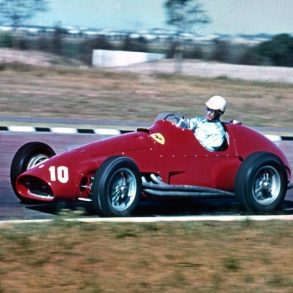
Ferrari 625 F1
Season: 1954 - 1956
For the 1954 season and the return to Formula One engine regulations, Ferrari 500 chassis were modified for the new regulations with the 2.5-litre 625 engine and would win two more races, one each in 1954 and 1955. The 625 F1 was good for 207 - 227 hp.
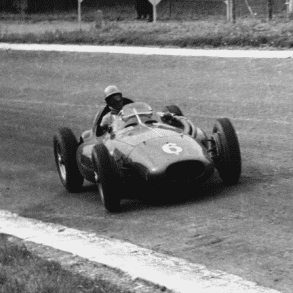
Ferrari 555 F1
Season: 1954
In 1955, Ferrari updated the 553 F1 car with new front and rear suspension springs as well as a new five-speed gearbox replacing its four-speed. Capacity and power were unchanged. It also got a nickname like the 553, now known as the 'super shark' or 'supersqualo'. The team only had one win.
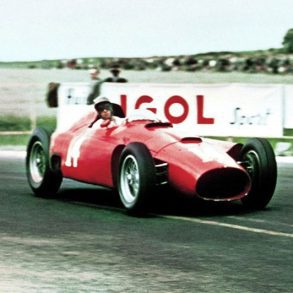
Ferrari-Lancia D50
Season: 1955 - 1957
The Lancia D50 was a Formula One racing car designed by Vittorio Jano for Lancia in 1954. The car was rebadged as the "Lancia-Ferrari D50" and later simply the "Ferrari D50" when the assets of Scuderia Lancia were given to Scuderia Ferrari (following Lancia company issues).
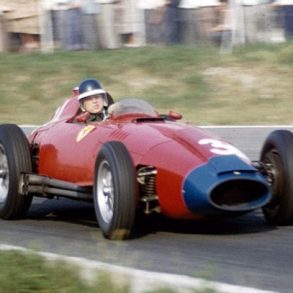
Ferrari 801 F1
Season: 1957
The D50s lived on into the 1957 season, much modified as "Ferrari 801s" but were largely uncompetitive against the latest generation of Maserati 250Fs. After the successful 1956 season, the 1957 season was a very bad one especially when two of the drivers died early in the season.
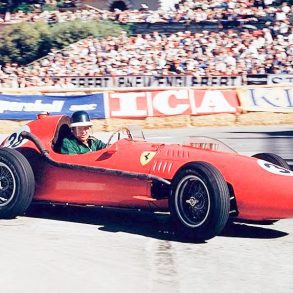
Ferrari 246 F1
Season: 1958 - 1960
The 246 made its track debut in 1958 at the Argentine GP, and took the driver Mike Hawthorn on to the world championship. The Drivers’ title returned to Ferrari, but the season was marked by the fatal accidents of Luigi Musso, at Silverstone, and Peter Collins, at the Nürburgring.
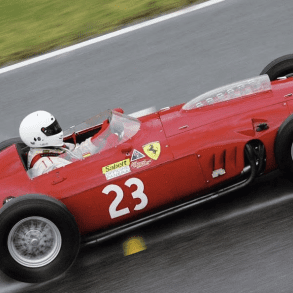
Ferrari 256 F1
Season: 1959
In 1959, to make a full use of the allowed capacity regulations, Ferrari enlarged the bore of the Dino V6 engine of the 246 F1 car, making it 2.5 liters. Another difference from the 246 was the fitting of disc brakes. Ferrari won in the French and German Grands Prix, but outgunned by Coopers.
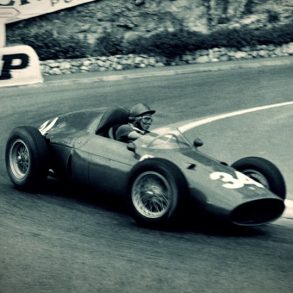
Ferrari 246 P F1
Season: 1960
Ferrari started 1960 with the 256 until the all-new rear engined car was ready for the Monaco race. The mid-engined 246 P F1. Ferrari nailed it and even used it as the base for the 156 F2, built later that same year, and for the 1961 season 156.
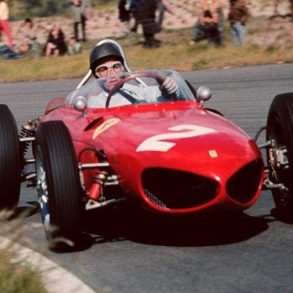
Ferrari 156 F1
Season: 1961 - 1964
Ferrari won both the Drivers and Constructors Championships in 1961 in the 156 F1, winning five of its eight Grands Prix races. Developed from the previous year’s F2 it had a lower center of gravity and better stability as a result, thanks to the 120° vee-angle between the cylinder banks instead of the 65° used on the Dino series.
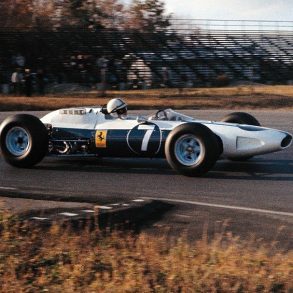
Ferrari 158 F1
Season: 1964 - 1965
John Surtees' 1964 Formula 1 title came courtesy of the Ferrari 158 F1. It signalled the return of the V8 to Maranello and was the first Ferrari Formula One car to use a monocoque chassis. In an odd moment during the season, the last two races had cars painted not in the traditional Rosso corsa but in white and blue.
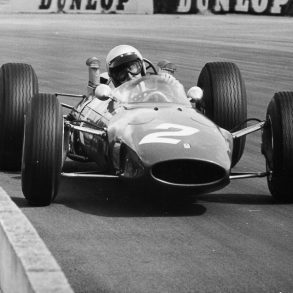
Ferrari 512 F1 (1512)
Season: 1964 - 1965
Ferrari also built a flat-12 powered Formula One car using the same chassis as the 158, designated the Ferrari 1512 or Ferrari 512 F1. The 1512 was designed to be competitive on the longest, fastest circuits of the Formula One season. With new rules the following year, Ferrari focused on the new racing car.
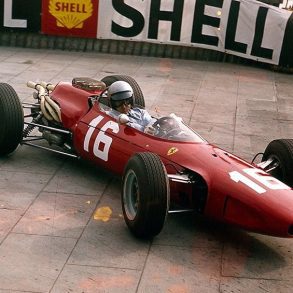
Ferrari 246 F1-66
Season: 1966
The Ferrari 246 F1-66 was used in a total of 4 races by 3 drivers, achieving a second and a third place. It was used during the season alongside the Ferrari 312. Almost identical to the Ferrari 158, except for the bigger 2.4-litre engine.
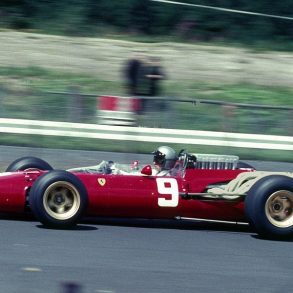
Ferrari 312 F1
Season: 1966 - 1969
The V12 was back for Ferrari but success was not. There were two distinct variations using this designation, the 1966 version and the completely different 1967-69 version. All in all, Ferrari managed just two victories by the end of the season.
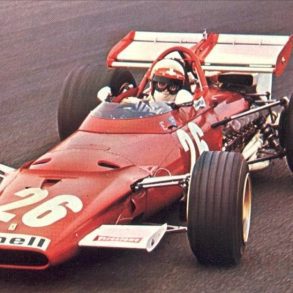
Ferrari 312 B
Season: 1970
The Ferrari 312B was the successor to the Ferrari 312 and was used from 1970 until early 1975. The original 312B was developed into the 312B2 and 312B3. During its first season Ferrari won three Grands Prix in the 312B. Almost won the Constructors title.
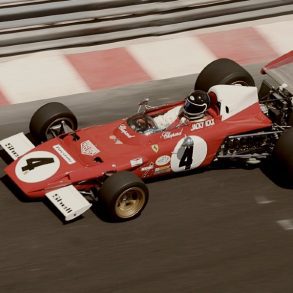
Ferrari 312 B2
Season: 1971 -1973
The 312 B2 showed up for the third race of the 1971 season (Monaco). This was a new car with an engine with shorter stroke, increasing its power at higher revs. It was good enough to get Ferrari to 3rd position in 1971 and 4th in 1972.
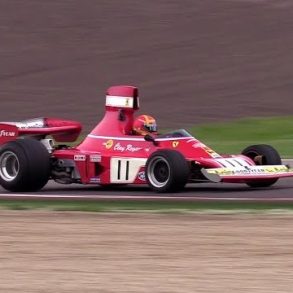
Ferrari 312 B3
Season: 1973 - 1974
The new 312 B3 debuted at the Spanish round (Ferrari used the 312 B2 for the first few rounds), but it proved to be slow and unreliable achieving even worse results than the B2. Ickx and Merzario can do no better than fourth place in 1973. Updated in 1974 (312 B3-74) made the car more competitive car and good for 10 poles.
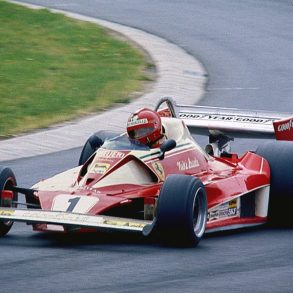
Ferrari 312 T
Season: 1975 - 1976
Based on the 312 B3 from 1974, the 312 was used from 1975 until 1980 in various forms. It was very successful, with Ferrarin winning both titles that year. A new gearbox, a more prominent wing, modified suspension and better reliability were all the result of details-focused Nicki Lauda during development.
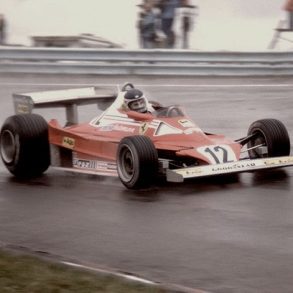
Ferrari 312 T2
Season: 1976 - 1978
A change in the rules meant that Ferrari had to come up with a new car. The year began as the last one had ended with Ferrari dominating the scene (six victories in the first nine races). The 312 T2 proved a worthy successor to the old car and gave Lauda a huge lead in the rankings. This was the year or Lauda's fieri crash.
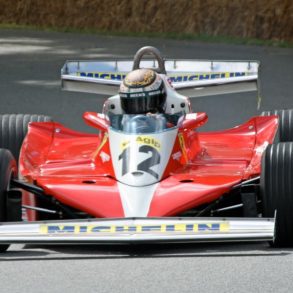
Ferrari 312 T3
Season: 1978 - 1979
The 312T3 was introduced for Villeneuve and Reutemann at the third race of the 1978 season. The car featured the same flat 12 engine as had been used since 1970, albeit tuned to give around 515 bhp. The chassis was completely new, with a new monocoque structure and a different suspension arrangement.
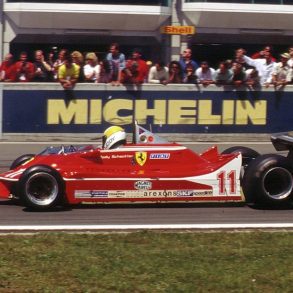
Ferrari 312 T4
Season: 1979
In 1979, a significant amount of progress was made in aerodynamics. The car was extremely reliable and it won 6 races in 1979. The car helped Ferrari win its fourth Constructors' Championship in 5 seasons and also helped Ferrari Drivers' Championship for Jody Scheckter.
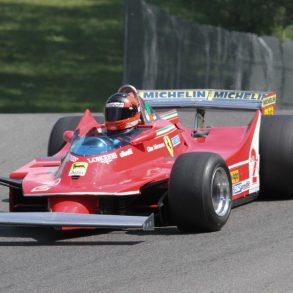
Ferrari 312 T5
Season: 1980
The 1980 season saw further aerodynamic progress by Cosworth DFV teams, and a heavily updated version of the 312T4, the 312T5 was introduced at the start of the season. The Ferrari was totally outclassed as their wide 312 "Boxer" engine did not suit the aerodynamic needs.
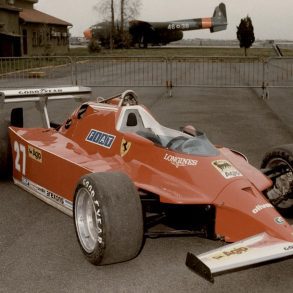
Ferrari 126 C
Season: 1981
The Ferrari 126C was designed to replace the highly successful but obsolete 312T series in use since 1975. The basic chassis was almost identical to the previous car but the smaller and narrower V6 with forced induction suited the ground effect aero now needed to be competitive.
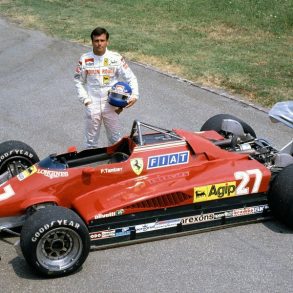
Ferrari 126 C2
Season: 1982 - 1983
Proved itself to be quite competitive and in the end, won the Constructors’ title. It was a development of the previous model but was 20 kg lighter. Gilles Villeneuve was killed practice and shortly after, Didier Pironi was severely injured in warm-up and had to pull out of the rest of the season.
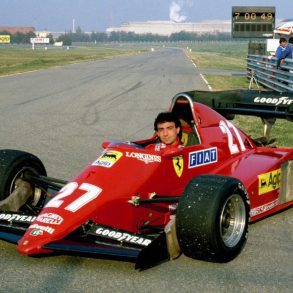
Ferrari 126 C3
Season: 1983
Mandatory flat bottoms for the cars were introduced for 1983, reducing ground effect, and a redesigned "B" spec. version of the 126C2 was introduced. René Arnoux almost took the Drivers’ title. He remained in the running right until the last race. C3 only replaced C2 after race 17.
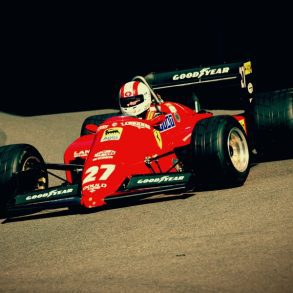
Ferrari 126 C4
Season: 1984
McLaren dominated the 1984 season and the C4 was only able to win one race all year. At the end of the season, Ferrari came second in the Constructors’ Championship, but was a long way back. The arrow shape was even more pronounced in the C4 and engine power was up 10% on the prior year.
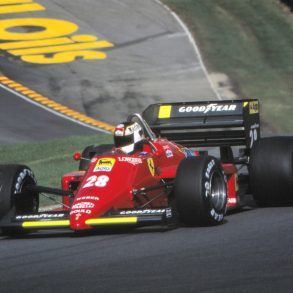
Ferrari 156_85
Season: 1985
The Ferrari Tipo 031/2 V6 turbo engine produced around 900 bhp in 1985, a sign the power wars were getting out of hand. The driver’s position was very far forward, it has a longer wheel base, radiators parallel to the direction of movement and big wheel hubs. Very competitive but lacked reliability.
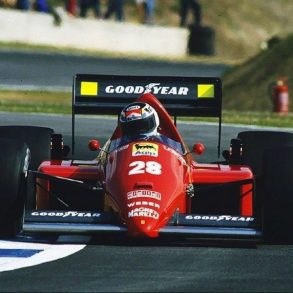
Ferrari F1-86
Season: 1986
1986 was not a good year for Ferrari, with a winless season. The car was very uncompetitive, despite the engine being regarded as one of the strongest on the grid. The car performed particularly impressively in qualifying but couldn't win. It was replaced by the Ferrari F1/87 for the 1987 season.
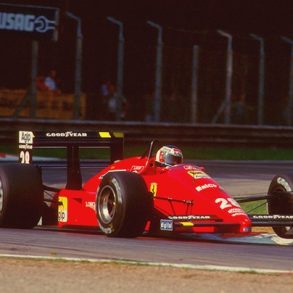
Ferrari F1-87
Season: 1987
The new engine was rated at approximately 950 bhp for qualifying and 880 bhp for races. The car was pretty quick and competitive early in season but suffered from persistent understeer. Late in the season a new wing made it competitive but wasn't reliable enough.
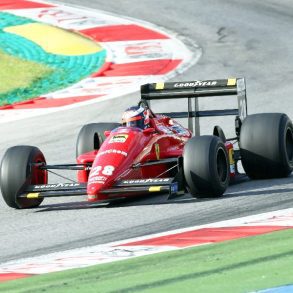
Ferrari F1-87/88C
Season: 1988
For 1988, the car was updated to conform to the new regulations and renamed the F1/87/88C. The car also featured new front and rear wings and a slightly lower engine cover due to the reduction in the fuel tank limit from 195 to 150 litres. Most powerful and thirstiest in field.
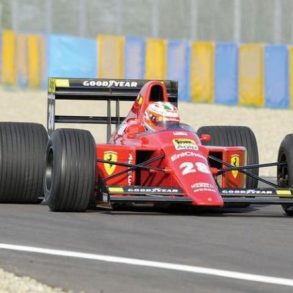
Ferrari 640 F1-89
Season: 1989
1989 was great for Ferrari, winning three times and taking third in the Constructors’ with 59 points. The F1-89 hailed the return of the normally aspirated 12-cylinder and in a major first for Formula 1, also had a gear change bar mounted behind the wheel. Mansell won his debut race.
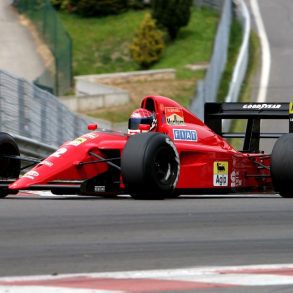
Ferrari 641 F1-90
Season: 1990
Based on the 1989 Ferrari 640, the design of the car remained largely unchanged apart from a few subtle modifications to the flanks. Improved engine’s cooling and breathing and a new more efficient gearbox made a difference. A shorter, more powerful engine arrived in Imola.
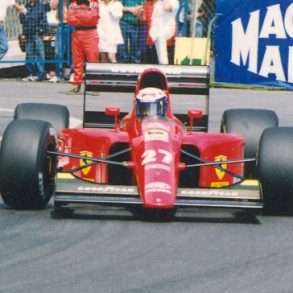
Ferrari 642 F1-91
Season: 1991
The Ferrari 642 was a development of the team's 641 chassis, which had mounted a championship challenge in 1990. A host of modifications had been made, including a longer wheel base and longer flanks with straight central sections. Ferrari only managed half of the previous season’s points.
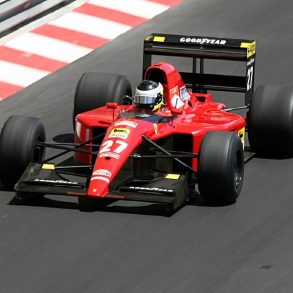
Ferrari 643 F1-92
Season: 1991
Built during May and introduced at the French Grand Prix it initially looked to have the potential to run at the front. The car scored 39.5 points of the team's 55.5 points in 1991. The 643 was tested in early 1992 by Ivan Capelli for being replaced at the start of the 1992 season by the Ferrari F92A.
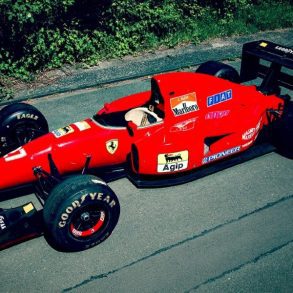
Ferrari F92A
Season: 1992
There were two versions of the F92A car, the original version raced in the first eleven races of the season, with the updated F92AT version racing in the latter stages of the season. The F92 A was not up to the competition and the Scuderia scored just 21 points by the end of the season.
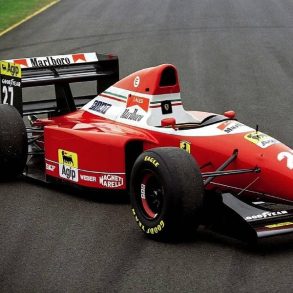
Ferrari F93A
Season: 1993
The Scuderia came just fourth in the Constructors’ Championship with 28 points in 1993. The best result of the season was a second at Monza. The 65° V12 engine remained but the new version debuted at the German GP. It had pneumatic springs for the valves that upped the revs and thus the power.
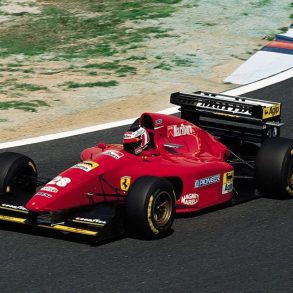
Ferrari 412 T1
Season: 1994
The car was a simple and straightforward design that worked well, powered by a 3.5 litre V12 engine. In the name of the new car. The 4 stood for the number of valves per cylinder while the 12 was for the number of cylinders and the T referred to the transverse gearbox. Ferrari came third.
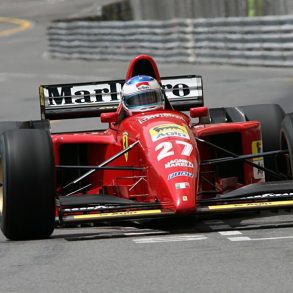
Ferrari 412 T2
Season: 1995
New regulations limiting engines to 3 liters meant that the 412 T2 was basically the same car as prior year. The last Formula One car to win a World Championship race using a V12 engine, the 412 T2 was also the last Formula 1 car powered by a V12 engine. Got 3rd in Constructors title.
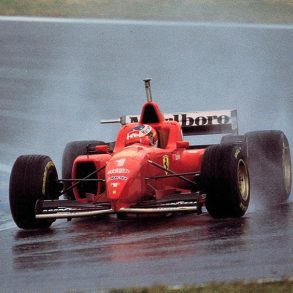
Ferrari F310
Season: 1996
Things were looking up for Ferrari in 1996. Michael Schumacher and Eddie Irvine drove for the team and the F310 with its V10 engine proved to be a very competitive car which couldn't quite catch the Williams FW18 but showed Ferrari was on the right track and back with a chance.
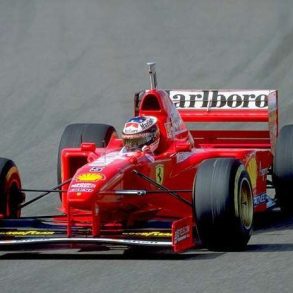
Ferrari F310B
Season: 1997
Much more reliable than its predecessor but suffered stability issues at the front. A new front wing assembly introduced shortly after Brawn and Byrne joined the team improved the package. Schumacher won 5 GPs and fought it for the title in the last race with Jacques Villeneuve.
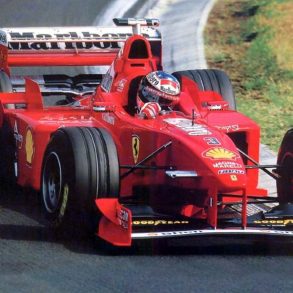
Ferrari F300
Season: 1998
New technical regulations for 1998 meant a totally new car for Ferrari. It was powered by the 3-litre Ferrari Tipo 047 V10 engine and designed around a narrower track with novel aerodynamic solutions by the technical team at Ferrari leading to years of future success. 1998 saw Michael Schumacher compete for the world title again, narrowly missing out.
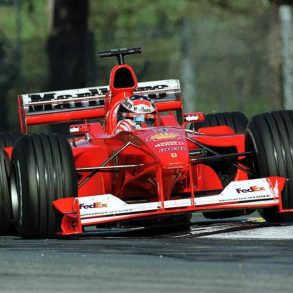
Ferrari F399
Season: 1999
The F399 was almost identical to the previous season's F300, with small detail changes (new front wing, wheel tethers, waisted sidepods and an improved exhaust system. The engine was the 048 which was lighter than the 047 with a bit more power too. In 1999 Ferrari won the Constructors’ title for the first time in 16 years and just lost the Driver’s title.
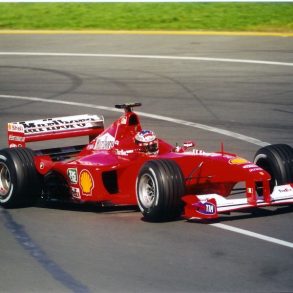
Ferrari F1-2000
Season: 2000
The F1-2000 was a direct development of the F300 and F399 from the previous two seasons, using the same basic gearbox and a new engine with a wider V-angle in the 048 engine, lowering the center of gravity and improving handling. It also featured improved aerodynamics over the F399. Ferrari's won the Constructors' title and Michael won the Driver's title.
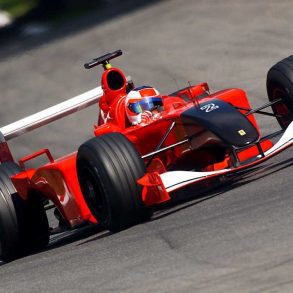
Ferrari F2001
Season: 2001 - 2002
The F2001 was designed around new regulation changes which mandated a higher-mounted front wing assembly to reduce downforce and saw the re-introduction of traction and launch control systems. The season was all Ferrari, with Michael Schumacher winning nine racess and his fourth world championship. It raced at the beginning of 2002.
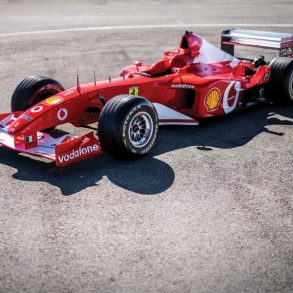
Ferrari F2002
Season: 2002 - 2003
The similarities with the F2001 were deceptive as the new car had been totally redesigned nd had much more performance. The chassis was a new, much lighter structure. The new 051 engine was paired with a fused titanium gearbox. The result was another winning season for Ferrari, totally dominating.
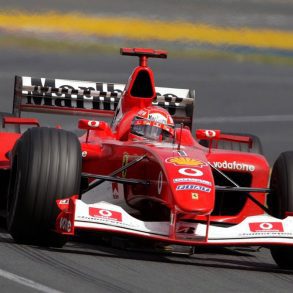
Ferrari F2003-GA
Season: 2003 - 2004
The thinking behind the car was the same as for the F2002: optimization of air flow, weight reduction and lowering of the centre of gravity. The rear end was revised and the suspension modified to get the best out of the Bridgestone tires. The car won seven races, five pole positions, and five fastest laps.
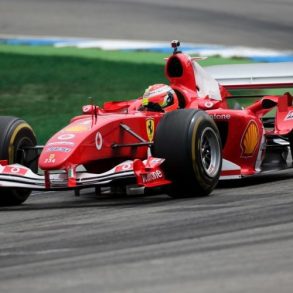
Ferrari F2004
Season: 2004
The dominant F2004 in 2004 was almost identical to its predecessor. The 053 engine was created to be as reliable as possible as the new rules stipulated that it had to last twice as long as its predecessor. The centre of gravity of the F2004 was lower too. It is one of the most dominant cars in the history of F1.
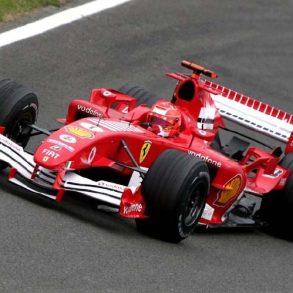
Ferrari F2005
Season: 2005
This is the last Ferrari F1 car to feature a V10 engine (very sad for us F1 fans). Unfortunately for Ferrari, the F2005 car was not nearly as successful a car as its predecessors, able to win only a single race all season. The 2005 season ended up being Ferrari worst showing since 1995. Renault and McLaren beat Ferrari up.
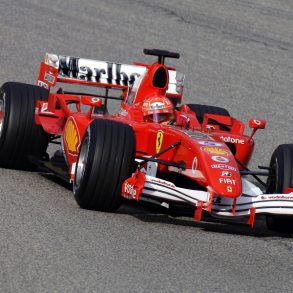
Ferrari 248 F1
Season: 2006
The 248 F1 welcomed back the V8, a 2.4 liter screamer. The car was an update of the previous year's F2005 in terms of chassic. Although the V8 engine is shorter than the V10 used in the F2005, the wheelbase is actually the same. Ferrari won 9 races and came second in both Drivers' and Constructors' titles.
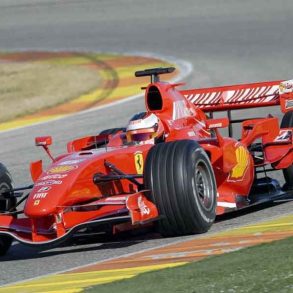
Ferrari F2007
Season: 2007
The car is best known for providing Kimi Räikkönen with his first World Championship title and the team with its first Constructor's title since Michael Schumacher helped them win both in the 2004 Formula One season. A nice comeback from Ferrari who had gone a few years without winning.
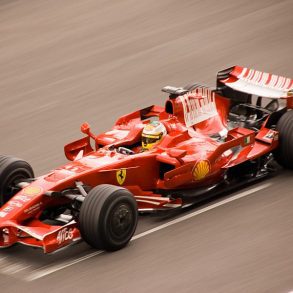
Ferrari F2008
Season: 2008
The F2008 remains the most recent Ferrari Formula 1 car to win the World Constructors' Championship. The car weighed more than the F2007 chassis due to rule changes which include the gearbox which has to be used for four consecutive races, higher side protection around the driver's helmet.
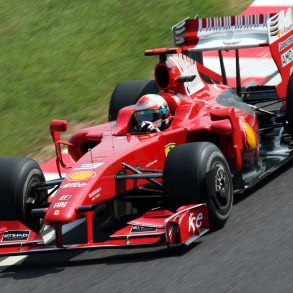
Ferrari F60
Season: 2009
The 2009 season was disappointing in many ways for Ferrari. After scoring no points in the first 3 races of the season, the F60 scored its first points in Bahrain, the fourth race of the season. Despite new technical regulations meant to slow the cards down, the 2009 car was faster than its predecessor on almost all tracks.
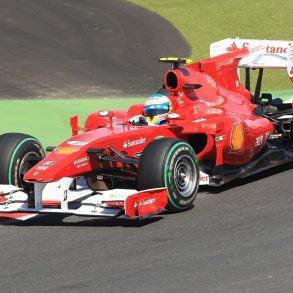
Ferrari F10
Season: 2010
The F10 proved immediately more competitive than its predecessor, with Felipe Massa and Fernando Alonso starting strong out of the gates. At the last race at Abu Dhabi, Alonso had a chance to win the title, only to miss out thanks to bad strategy and bad luck.
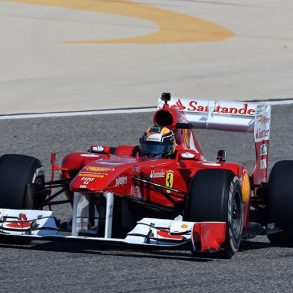
Ferrari 150° Italia
Season: 2011
When the season began in Australia, many were surprised by Ferrari's noticeable lack of pace, particularly in qualifying. Unfortunately it was no one-off situation, with Ferrari lacking competitiveness the entire season. Alonso won in Great Britain but that's it.
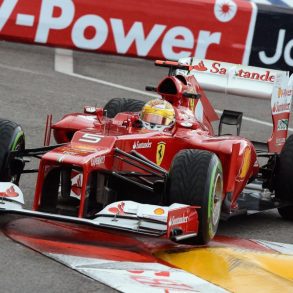
Ferrari F2012
Season: 2012
Like most 2012-specification cars, the F2012 featured a 'stepped nose' to conform to new FIA safety regulations. Despite the car’s significant lack of performance, Alonso managed to mount a challenge for the title until the last race held in Interlagos (missed by 3 pts).
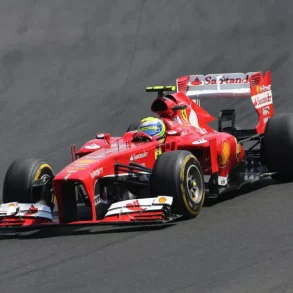
Ferrari F138
Season: 2013
Ferrari were developing their car for the 2014 season in parallel with the F138, so many admit the company lacked focus on the 2013 season knowing they were outgunned. Despite a few upgrades throughout the year, the team was just not able to challenge for victories.
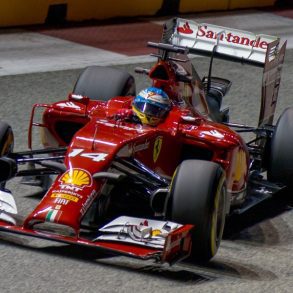
Ferrari F14 T
Season: 2014
The F14 T was the first turbo powered Formula One car for Ferrari since the Gustav Brunner designed F1/87/88C driven by Michele Alboreto and Gerhard Berger in 1988. Even with the lineup of Alonso and Räikkönen, the car was not successful, scoring only two podium finishes (both by Alonso) in the entire season.
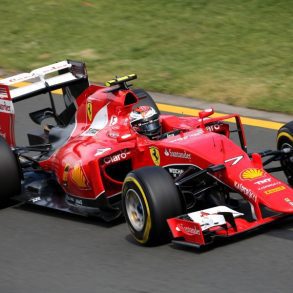
Ferrari SF15-T
Season: 2015
Ferrari finished the season 2nd in the Constructors' table with 428 points, nearly doubling their point total from the previous year. They proved to be the only true challenger to the dominant Mercedes team, as they were the only other team to win races. Mercedes were just too strong and it was really no contest to be honest.
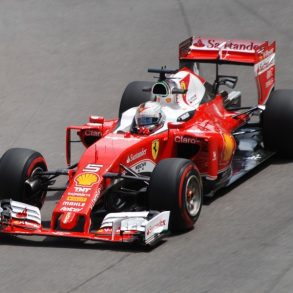
Ferrari SF16-H
Season: 2016
The Ferrari SF16-H was Ferrari's challenger for the 2016 Formula One season. 1 Driven by Sebastian Vettel and Kimi Räikkönen, it represented a significant step forward in design compared to its predecessor. The "H" in its name stood for "Hybrid". Ultimately lacked the consistency to challenge Mercedes for the championship.
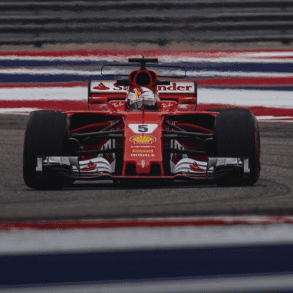
Ferrari SF70H
Season: 2017
The car proved to be fast in pre-season testing, and it carried its form into the first race of the season, the Australian Grand Prix. But once again the Mercedes cars were just too strong and handily beat the Ferraris all season long. The team came second in the Constructors Championship but it wasn't even close to winning.
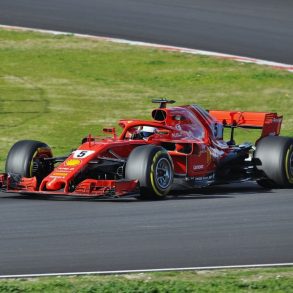
Ferrari SF71H
Season: 2018
The Ferrari SF71H was a Formula One car designed and built by Scuderia Ferrari for the 2018 Formula One World Championship. Driven by Sebastian Vettel and Kimi Räikkönen, it was a highly competitive car, securing 6 wins and 6 pole positions throughout the season. Vettel even nicknamed his car "Loria"! Although ultimately finishing second in the championship to Mercedes, the SF71H is considered one of the most successful Ferrari cars of the hybrid era.
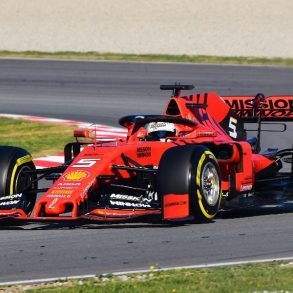
Ferrari SF90 F1
Season: 2019
The Ferrari SF90 was the Formula One car designed and built by Scuderia Ferrari to compete in the 2019 FIA Formula One World Championship. It marked the 90th anniversary of the Scuderia, hence the name SF90. Driven by Sebastian Vettel and Charles Leclerc, the car showed impressive pace, particularly in qualifying, securing 3 wins and 9 pole positions. However, it struggled with race pace and tire management, ultimately finishing second in the championship to Mercedes.
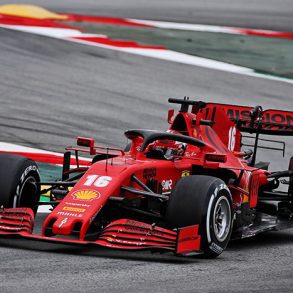
Ferrari SF1000
Season: 2020
The Ferrari SF1000 was Scuderia Ferrari's entry for the 2020 Formula One World Championship. 1 Marking Ferrari's 1000th Grand Prix race, the car carried significant expectations. Unfortunately, it proved to be one of their least competitive cars in recent history. Driven by Sebastian Vettel and Charles Leclerc, the SF1000 struggled with a lack of power and aerodynamic deficiencies, resulting in only 3 podium finishes and a disappointing sixth place in the constructors' championship.
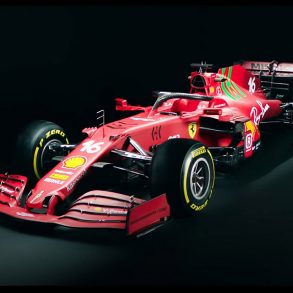
Ferrari SF21
Season: 2021
The Ferrari SF21 was Scuderia Ferrari's 2021 Formula One challenger, marking a transitional year for the team. 1 Driven by Charles Leclerc and new teammate Carlos Sainz Jr., the SF21 was a significant improvement over its predecessor, the SF1000. Although it didn't secure any race wins, the car consistently scored points, with both drivers achieving multiple podium finishes. This strong performance allowed Ferrari to secure third place in the constructors' championship.
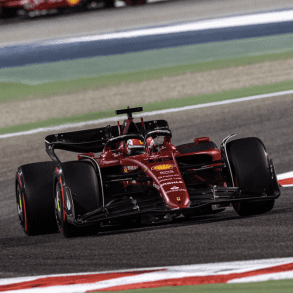
Ferrari F1-75
Season: 2022
The Ferrari F1-75 was Scuderia Ferrari's 2022 Formula One car, named in honor of the 75th anniversary of the first Ferrari production car. Driven by Charles Leclerc and Carlos Sainz Jr., it marked a return to competitiveness for the team. The F1-75 was incredibly fast, especially in qualifying, securing 4 wins and 12 pole positions. Its unique sidepod design was a standout feature. While reliability issues and strategic errors hampered their championship fight, the F1-75 signaled a resurgence for Ferrari and provided a strong foundation for future development.
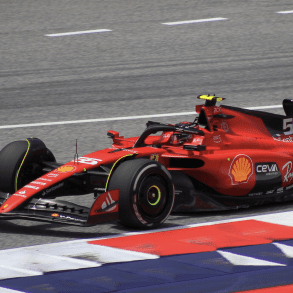
Ferrari SF-23
Season: 2023
The Ferrari SF-23 is the car Scuderia Ferrari used to compete in the 2023 Formula One World Championship. Driven by Charles Leclerc and Carlos Sainz Jr., it was designed as an evolution of its predecessor, the F1-75. While initially showing promise, the SF-23 struggled with inconsistency and tire degradation throughout the season. A mid-season upgrade package introduced a significant change to the car's sidepods, but ultimately, Ferrari finished 4th in the constructors' championship. It highlighted the ongoing challenges faced by the team.
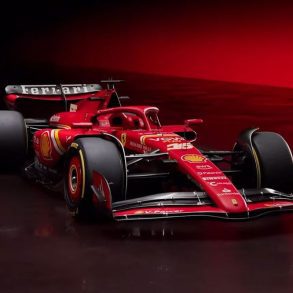
Ferrari SF-24
Season: 2024
The Ferrari SF-24 is Scuderia Ferrari's contender for the 2024 Formula One World Championship. Piloted by Charles Leclerc and Carlos Sainz Jr., it represents the team's latest effort to reclaim championship glory. Early in the season, the SF-24 has shown impressive pace, securing several podiums and a 1-2 finish at the Australian Grand Prix. The car features revised aerodynamics and a focus on improved tire management, addressing key weaknesses of its predecessor. Whether it sustain this performance and challenge remains to be seen...

Coming Soon
Season: 2025
Coming Soon
Ferrari Formula 2 & Single Seaters
Ferrari competed in Formula 2, especially during the early era when the two series were so similar and rules were often shared. In addition Ferrari would get upset with Formula One rule-makers and would threaten to leave so that also created some fun cars especially during the mid 1980s.
Ferrari 166 F2 (1948 - 1951)
Ferrari 500 F2 (1951 - 1953)
Ferrari 553 F2 (1953)
Ferrari Dino 156 F2 (1957 - 1960)
Ferrari 156 F2 (1957)
Ferrari Dino 166 F2 (1967 - 1969)
Ferrari 166 FL (1949)
Ferrari 375 Indianapolis (1952)
Ferrari 326 MI (1958)
Ferrari 412 MI (1958)
Ferrari Dino 246 Tasmania (1968 - 1971)
Ferrari 637 CART (1986)
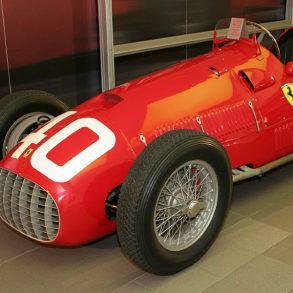
Ferrari 166 F2
Season: 1948 - 1951
The very first Ferrari racers were used for a variety race and changed only in detail for the type of event; for a single seater race the fenders were removed for example. The most successful of the early V12 engined Ferrari single seaters were no doubt the Formula 2 cars. Replaced in 1952 by 4 cylinder 500 F2.
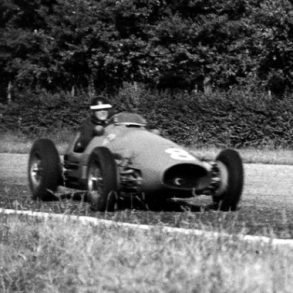
Ferrari 500 F2
Season: 1951 - 1953
The car was powered by an inline four-cylinder engine which was mounted behind the front axle. This car dominated the two F2 seasons and Ascari took the two first world titles for himself and for Ferrari. Ascari won seven consecutive World Championship races in the 500 (a record till Vettel beat it in 2013).
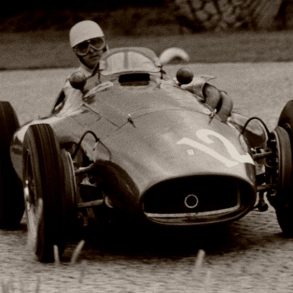
Ferrari 553 F2
Season: 1953
In 1953 Ferrari updated the F2 car. The engine was completely redesigned, with a shorter stroke and other modifications and, thanks to complete interchangeability, could also be used in the F1 version. Ferrari did well but was outgunned by Fangio and the Maserati car.
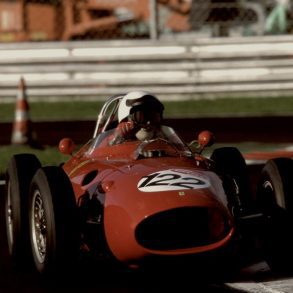
Ferrari Dino 156 F2
Season: 1957 - 1960
Powered by an all-new, front-mounted, 65° Dino V6, this F2 racer was a seminal car because it helped create a whole new generation of V6-powered Ferrari cars. The angle of the cylinder blocks allowed for the engine to have a lower centre of gravity which made it a high performance racer.
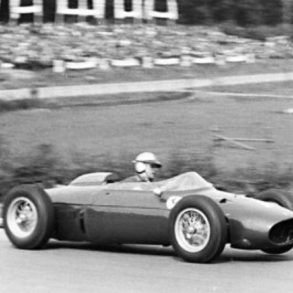
Ferrari 156 F2
Season: 1957
It was also fitted with a 1.5-litre engine on occasion where it conformed to F2 regulations and was also known as Ferrari 156 F2 or 156 P when it was heavily revised for 1960 Italian Grand Prix as well as other races in 1960, including 1960 Solitude Grand Prix and 1960 Modena Grand Prix.
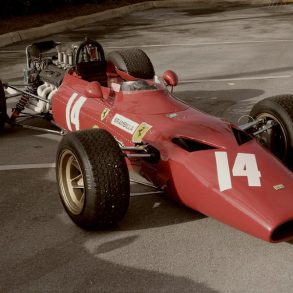
Ferrari Dino 166 F2
Season: 1967 - 1969
A change in F1 rules for 1966 brought changes to Formula 2 as well. New homologation requirements meant that at least 500 production units of the same engine block had to made. Ferrari worked with Fiat... so for the 1967 European Championship season they were able to field a new car, the Dino 166 F2.
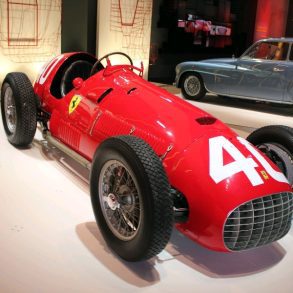
Ferrari 166 FL
Season: 1949
The most successful of the early V12 engined Ferrari single seaters were no doubt the Formula 2 cars. Originally conceived as a Formula 2 car in 1949, these early Ferraris have story whereby Juan Manuel Fangio bought one with backing from the Argentinean government. The 166 FL is one of those cars.
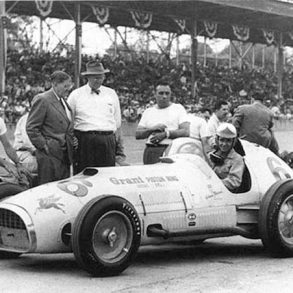
Ferrari 375 Indy
Season: 1952
This single-seater was built to race in the Indy 500 and the Ferrari technical staff had worked hard to reduce certain settings to comply with the rules for that race. Ascari drove it well on its track debut but even his considerable skills could not make up for the single-seater's lack of top speed.
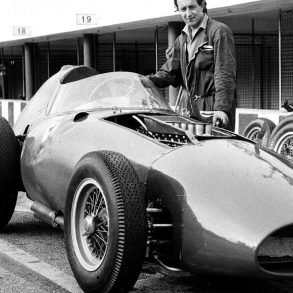
Ferrari 326 MI
Season: 1958
The Ferrari 326 MI (also known as the 296 MI) was a one-off racer purpose-built for the second edition of the 500 Miles of Monza. It was one of the two special cars created to compete with American race cars on an Italian race track. Following the naming convention, "326" stood for 3.2-litre, 6-cylinder engine. The "MI" suffix stood for "Monza-Indianapolis"
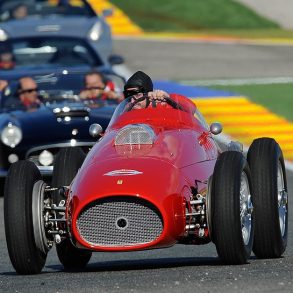
Ferrari 412 MI
Season: 1958
Purpose-built to compete with American cars at the Indianpolis 500 and the Race of Two Worlds at Monza. It used a unique version of Ferraris current sports car V12. To cope with the near 450 bhp, an old 375 F1 was used. At the 1958 Race of Two worlds, Mike Hawthorn and Juan Manuel Fangio completed three grueling heats, and placed third.
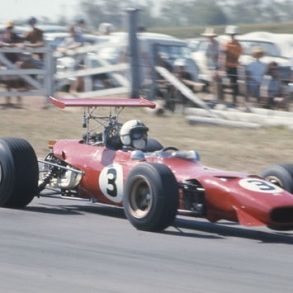
Ferrari Dino 246 Tasmania
Season: 1968 - 1971
Rule changes in F1 for 1968 meant Ferrari needed to find other racing venues for their already existing projects. The Tasman Series for cars up to 2500 cc was just that venue and the Dino 246 Tasmania was just such a car. Converted from the Dino 166 Formula 2 basis with the engine enlarged to 2.4 L to meet the requirements..
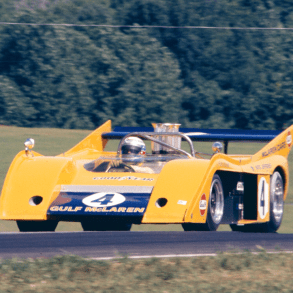
Ferrari 637 CART
Season: 1986 (Did not race)
The Ferrari 637 was designed to run in the American CART series. It was designed by Gustav Brunner and, although tested and unveiled to the press in 1986, it never raced. It came at a time when Ferrari was mad at Formula One rulemakers so this was his threat to leave the sport.
Ferrari XX Race Cars
In this section we focus on Ferrari's FXX programs as well as special edition track-only cars. The Ferrari FXX is a high-performance track-only developmental program where Ferrari takes street-legal flagship models and turns them into track cars. It is a more bit complicated though. Customers pay a few million dollars but are only allowed to drive the car on special track days which are approved by Ferrari. The FXX may be stored by owners wherever they please. The caveat behind the FXX is only that Ferrari technicians must look over the car before the car hits the track in any event or private testing session. The owners of the FXX also participate in Ferrari's testing and brand development programs. The purpose of this particular program is to offer Ferrari’s most privileged customers the opportunity to – along with owning the car – participate in up to track test days. This was done while a team of Ferrari employees provided track-side support, a pit crew, and engineers tasked with mining data during each session for research and development purposes.
Ferrari FXX (2005 - 2007)
Ferrari FXX Evoluzione (2008 - 2009)
Ferrari 599XX (2009 - 2010)
Ferrari 599XX Evoluzione (2011 - 2012)
Ferrari FXX-K (2015 - 2017)
Ferrari FXX-K Evo (2017 - 2019)
Ferrari P80/C (2019)
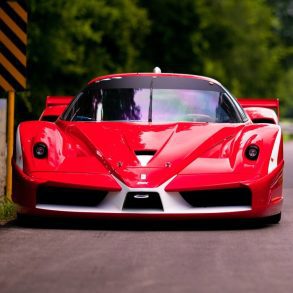
Ferrari FXX
Years: 2005–2007
The FXX was an evolution of the Enzo in essence, made into a serious race car. Significant developments were made. The FXX's engine is based on Enzo's, but displacement has been increased to 6.3 L (up from 6.0 L). Power output is up from 651 hp to a mighty 789 hp. The FXX also has a lot of comprehensive data-monitoring and telemetry. Learn More
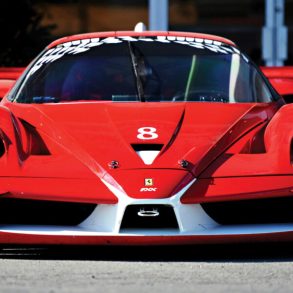
Ferrari FXX Evo
Years: 2008 - 2009
The Ferrari FXX program continued until 2009 (2007-2009), with the FXX Evoluzione. The FXX Evoluzione was improved from the standard FXX by continually adjusting specifics to generate more power and quicker gear changes, along with reducing the car's aerodynamic drag. Power is up to 848 hp and 0 - 60 mph is an absurd 2.5 s. Learn More
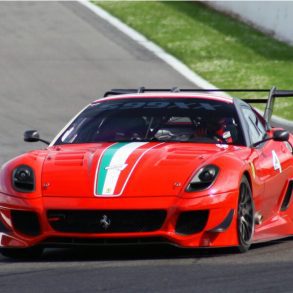
Ferrari 599XX
Years: 2009 - 2010
The 599XX is a non-road-legal version of the Ferrari 599, intended for use primarily at Ferrari-run track test days as part of the XX program. Ferrari announced at one point that the 599XX had lapped the Nürburgring in a time of 6 minutes and 58 seconds – the fastest time ever recorded by a production-based car, at the time. Learn More
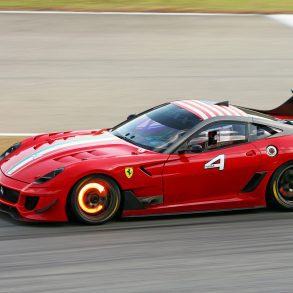
Ferrari 599XX Evo
Years: 2011 - 2012
The 599XX Evoluzione weighed 35 kg (77 lb) less than the standard 599XX and the engine had slightly improved peak power of 740 PS (544 kW; 730 hp) and 700 N⋅m (516 lb⋅ft) of torque. One of the key features of the Evoluzione is its active rear wing which can adjust automatically to increase cornering performance. Learn More
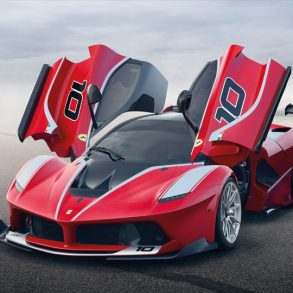
Ferrari FXX-K
Years: 2015 - 2017
The FXX-K has 1,036 hp and 664 lb/ft of torque delivered by its conventional V12 engine and electric motor. Insane. The FXX K’s 6262 cc V12 features new camshafts and a modified valve train with mechanical rather than hydraulic tappets. The intake manifolds have been redesigned and given a special type of polishing treatment. The exhaust system has been modified as its silencers have been eliminated. Learn More
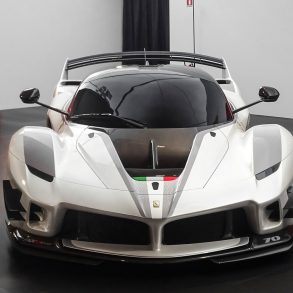
Ferrari FXX-K Evo
Years: 2017 - 2019
The FXX-K Evo is essentially an aerodynamic package available for the existing Ferrari FXX-K. The FXX-K Evo allows the car to produce 23% more downforce than the standard FXX-K and 75% more than the road-legal LaFerrari due to a modified front fascia, a large rear wing and underbody diffusers. Performance and weight figures are unknown but a 90 kg (198 lb) decrease in weight is said to estimated by the manufacturer. Learn More
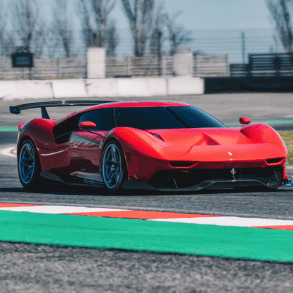
Ferrari P80/C
Years: 2019
The P80/C is “the most extreme one-off design ever,” and we believe it. Based on the 488 GT3 chassis the car’s design begins with one of the best racing chassis of all time. This is not part of the XX program, but we couldn't think off another category for it. The P80/C is a car that shares some parts with the GT3, but the body and the front splitter are unique. For a customer who wanted a "modern sports prototype". Learn More
Ferrari Challenge Race Cars
If you want to get into racing, Ferrari has you covered. We don’t just mean with fast cars—though it has plenty of those—but with actual race cars, the latest of which is the 2020 488 Challenge Evo. Meant for use in the brand’s Ferrari-only racing series, the aptly named Ferrari Challenge, the speedster’s design and performance have been refined to make it an even more competitive and capable car than before. The 488 Evo is another race car in a long line for Challenge cars Ferrari has developed for its very own race series and the latest is the 296 Challenge cars and series.
Ferrari 348 Challenge (1993 - 1995)
Ferrari F355 Challenge (1995 - 2000)
Ferrari 360 Modena Challenge (2000 - 2006)
Ferrari F430 Challenge (2006 - 2011)
Ferrari 458 Challenge (2011- 2013)
Ferrari 458 Challenge EVO (2014 - 2016)
Ferrari 488 Challenge (2018 - 2020)
Ferrari 488 Challenge EVO (2020 - 2023)
Ferrari 296 Challenge (2024 - Present)
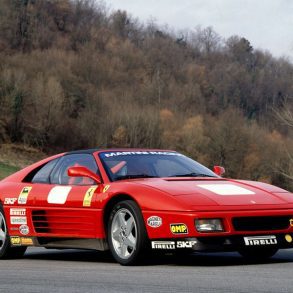
Ferrari 348 Challenge
Seasons: 1993 - 2000
The Ferrari Challenge was initiated by Ferrari Club Nederland and designated for the Ferrari 348; the series debuted in 1993 and included the Italian and European series. The engine used in the participating cars was similar to the road car with the only noticeable changes being the slick tires, new body kit, better brake-pads, roll-bar, smaller battery in a different position and seat belts.
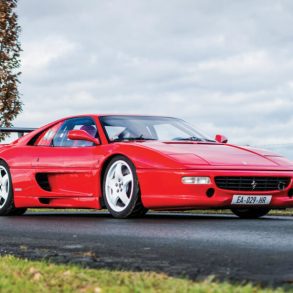
Ferrari F355 Challenge
Seasons: 1995 - 2000
In 1995, Ferrari introduced a race-ready F355 Challenge model for use specifically in the Ferrari Challenge race series. Ferrari only made 108 cars. The F355 Challenger cars had 3.5-liter quad-cam V8 paired with a six-speed manual. The car has a roll cage, Brembo brakes, and 18-inch Speedline wheels. Each year, the cars arrived with more and more factory fitted race parts, culminating in 1998 with full-evolution cars.
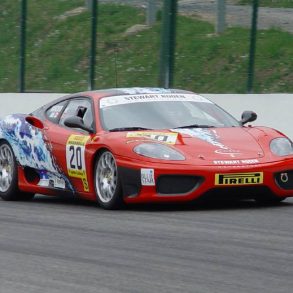
Ferrari 360 Modena Challenge
Seasons: 2000 - 2006
Unlike the previous Challenge race series, which used an F355 road car with a dealer-installed 'challenge upgrade' kit, the 360 Modena Challenge was a factory-built track car. The enhanced driving characteristics and substantial weight reduction meant the car was a track star, even though power from the 3.6-litre engine was unchanged. The adaptive suspension was replaced by adjustable racing dampers. Learn More
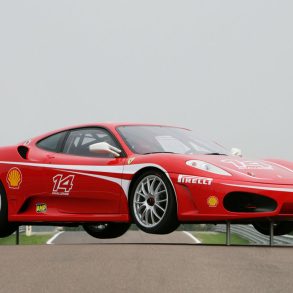
Ferrari F430 Challenge
Seasons: 2006 - 2011
Based on the F430 and using the same 4.3L V8 engine, the Ferrari Challenge and the Rolex Sports Car racing series car from 2006 was the F430 Challenge. Weight was reduced in every area of the car, from the engineering to the bodywork, helping the car down to 1225 kg. The E-Diff was replaced by a mechanical differential and the EBD was replaced with a mechanical system. It keeps the same 490 hp as the regular car. Learn More
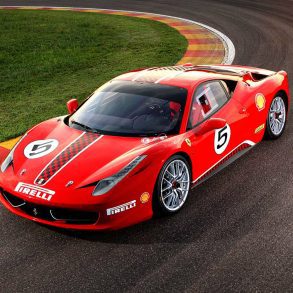
Ferrari 458 Challenge
Seasons: 2011 - 2014
The 458 Challenge introduced a number of important modifications to adapt it for competition use. The direct injection 4497 cc V8 remained strictly in production tune, with an output of 570 hp at 9,000 rpm. Modifications were made to the gear ratios and calibration of its dual-clutch F1 gearbox. The 458 Challenge is also equipped with the E-Diff electronic differential already employed on the road-going version, a first for Ferrari’s track-only cars. Learn More
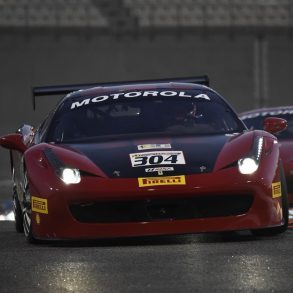
Ferrari 458 Challenge EVO
Seasons: 2014 - 2018
After running the 458 Challenge cars for three years Ferrari updated the model to Challenge Evoluzione-spec for 2014. The Evoluzione is a mandatory kit for 2014 that replaces both the front and rear fascias with more aggressive counterparts that are similar to the 458 GT3. Included is a substantial rear wing that has a multitude of adjustment points. The kit was developed with the help of Andrea Bertolini and Marc Gene. All three series ran the new model. Learn More
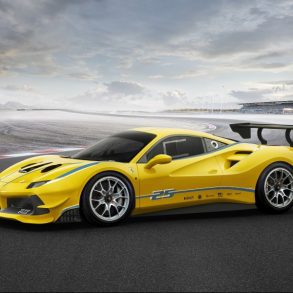
Ferrari 488 Challenge
Seasons: 2018 - 2020
Unveiled at the season-ending Finali Mondiali event at Daytona International Speedway. The 488 Challenge is the first in the series to feature a turbocharged V8 with 660 horsepower. It’s no doubt that this is the most powerful car in the series so far. The engine is now more lighter by at least 43 pounds and the exhaust is also lighter by about 19 pounds. The front bumper is given a new design as well as the hood. The rear wing is also larger than its predecessor. Learn More
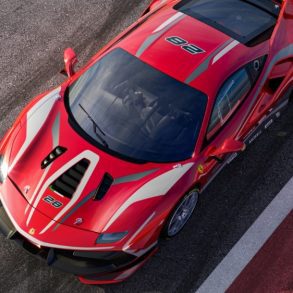
Ferrari 488 Challenge EVO
Seasons: 2020 - 2023
The track-ready car features an upgraded design and better performance. Where the 488 Challenge Evo differs most from its predecessor is its aero. The front of the car has been completely redesigned with larger intakes, including a u-shaped center intake that helps cool the vehicle’s carbon-ceramic brakes, along with a new splitter and canards. The changes give the car a more intimidating look but also improve its aerodynamic efficiency by 30 percent. Learn More
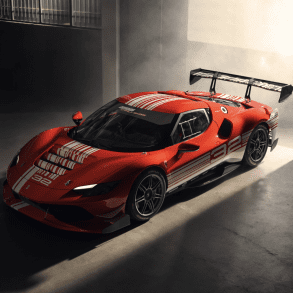
Ferrari 296 Challenge
Seasons: 2024 - Present
The Ferrari 296 Challenge is the latest addition to the Ferrari Challenge series, a single-make racing championship that pits drivers against each other in identical cars. Based on the 296 GTB, the Challenge car features a stripped-down interior, enhanced aerodynamics, and a race-tuned suspension. Its hybrid V6 powertrain is optimized for track use, delivering explosive acceleration and impressive fuel efficiency. Learn More
Ferrari Sports Cars & GT Racers
Ferrari won the 24 Hours of Le Mans nine times. It also contested the Manufacturer’s Championship for Sports Cars and Prototypes, then a crown jewel of the sport alongside Formula One, and between 1953 and 1967, it won 12 of those years. Ferrari's history with sports car racing is a long one, and the result has been some of the most memorable and most exciting competition cars ever made. In case you are wondering, below are almost 110 competition cars made by Ferrari. We think we got them all, please enjoy our list of every Ferrari sports cars and GT race ever made.
Ferrari 125 S (1947)
Ferrari 159 S (1947)
Ferrari 166 S/SC (1948)
Ferrari 166 MM (1948)
Ferrari 195 S (1950)
Ferrari 275 S (1950)
Ferrari 340 America (1951)
Ferrari 212 Export (1951)
Ferrari 225 S (1952)
Ferrari 250 S (1952)
Ferrari 340 Mexico (1952)
Ferrari 250 MM (1953)
Ferrari Ferrari-Abarth 166 MM/53 (1953)
Ferrari 625 TF (1953)
Ferrari 735 S (1953)
Ferrari 500 Mondial (1953)
Ferrari 340 MM (1953)
Ferrari 375 MM (1953)
Ferrari 750 Monza (1954)
Ferrari 250 Monza (1954)
Ferrari 375 Plus (1954)
Ferrari 118 LM (1954)
Ferrari 121 LM (1955)
Ferrari 376 S (1955)
Ferrari 735 LM (1955)
Ferrari 410 S (1955)
Ferrari 857 S (1955)
Ferrari 500 TR (1956)
Ferrari 860 Monza (1956)
Ferrari 290 MM (1956)
Ferrari 625 LM (1956)
Ferrari 250 GT Berlinetta "TdF" (1956)
Ferrari 290 S (1957)
Ferrari 500 TRC (1957)
Ferrari 315 S (1957)
Ferrari 335 S (1957)
Ferrari 250 Testa Rossa (1957)
Ferrari Dino 196 S (1958)
Ferrari Dino 296 S (1958)
Ferrari 312 S (1958)
Ferrari 412 S (1958)
Ferrari 250 GT Berlinetta "SWB" (1959)
Ferrari Dino 246 S (1960)
Ferrari 250 TR59 (1959)
Ferrari 250 TR59/60 (1960)
Ferrari 250 TRI60 (1960)
Ferrari 250 TRI61 (1961)
Ferrari SP series (1961)
Ferrari 246 SP (1961)
Ferrari 196 SP (1962)
Ferrari 286 SP (1962)
Ferrari 248 SP (1962)
Ferrari 268 SP (1962)
Ferrari 250 GT SWB Breadvan (1962)
Ferrari 330 TRI/LM (1962)
Ferrari 250 GTO (1962)
Ferrari 330 LM Berlinetta (1963)
Ferrari 250 P (1963)
Ferrari 250 GTO/64 (1964)
Ferrari 250 LM (1964)
Ferrari 275 P (1964)
Ferrari 330 P (1964)
Ferrari 275 P2 (1965)
Ferrari 330 P2 (1965)
Ferrari 365 P2 (1965)
Ferrari 275 GTB/C (1965)
Ferrari Dino 166 P (1965)
Ferrari Dino 206 SP (1965)
Ferrari 330 P3 (1966)
Ferrari Dino 206 S (1966)
Ferrari 330 P4 (1967)
Ferrari 412 P (1967)
Ferrari 350 Can Am (1967)
Ferrari 612 Can Am (1968)
Ferrari 212 E Montagna (1968)
Ferrari 312 P (1969)
Ferrari 512 S (1970)
Ferrari 512 M (1970)
Ferrari 312 PB (1971)
Ferrari 712 Can Am (1971)
Ferrari 365 GTB/4 Competition (1972)
Ferrari 512 BB LM (1979)
Ferrari 288 GTO Evoluzione (1987)
Ferrari F40 Compezione (1989)
Ferrari F40 CSAI-GT (1993)
Ferrari F40 LM (1989)
Ferrari F40 GT (1993)
Ferrari F40 GTE (1995)
Ferrari 348 GT Competizione (1994)
Ferrari 348 GT LM (1994)
Ferrari 333 SP (1994)
Ferrari F50 GT (1996)
Ferrari 550 GTS (2001)
Ferrari 360 Modena GT (2002)
Ferrari 360 N-GT/ Michelotto (2002)
Ferrari 360 Modena GTC (2004)
Ferrari 575 GTC (2004)
Ferrari 575 GTC Evoluzione (2003)
Ferrari F430 GTC (2006)
Ferrari F430 GT3 (2007)
Ferrari F430 Scuderia GT3 (2009)
Ferrari 458 Italia GT2 (2011)
Ferrari 458 Italia GT3 (2011)
Ferrari 458 Italia Grand-Am (2012)
Ferrari 488 GTE (2016)
Ferrari 488 GT3 (2016)
Ferrari 488 GT3 Evo (2020)
Ferrari 488 GT Modificata (2021)
Ferrari 296 GT3 (2023)
Ferrari 499P (2023)
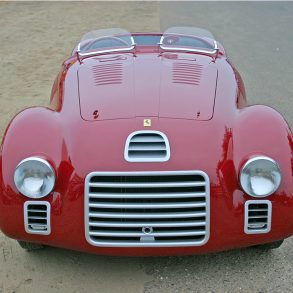
Ferrari 125 S
Year: 1947
Engine: 1.5 L Colombo V12
Predecessor: Costruzioni 815
Successor: 159 S
This was the very first car to wear the Ferrari badge. The V12 engine was designed by Gioacchino Colombo with contributions from Giuseppe Busso and Luigi Bazzi. Sport and competition versions of the 125 S were built with different bodywork although the chassis and running gear of the cars remained basically identical. Learn More
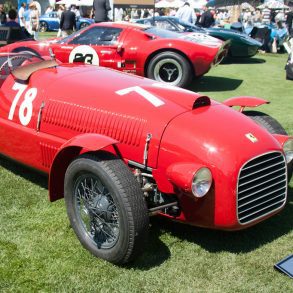
Ferrari 159 S
Year: 1947
Engine: 1.9 L Colombo V12
Predecessor: 125 S
Successor: 166 S
The Ferrari 159 S was the second Ferrari vehicle and succeeded the Ferrari 125 S that had won six of 14 races earlier in 1947. This car is very rare with only two 159S ever built. One of these rebuilt as a Ferrari 166 Spyder Corsa, and as of 2012, the oldest remaining Ferrari. The 159 S made its debut in the Coppa Acerbo in Pescara in 1947. Learn More
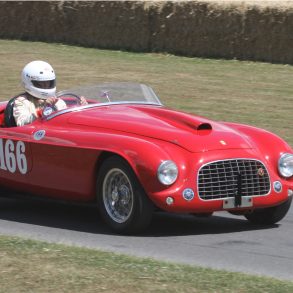
Ferrari 166 S/SC
Year: 1948
Engine: 2.0 L Colombo V12
Predecessor: 159 S
Successor: 195 S
The Ferrari 166 S was an evolution of Ferrari's 125 S sports race car that became a sports car for the street in the form of the 166 Inter. Only 39 Ferrari 166 S were produced, soon followed by the production of the 166 Mille Miglia (MM) which was made in much larger numbers from 1949 to 1952. The 166 MM was an updated 166 S. Learn More
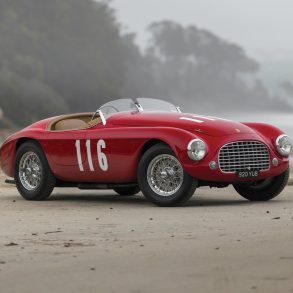
Ferrari 166 MM
Year: 1948
Engine: 2.0 L Colombo V12
Predecessor: 159 S
Successor: 195 S
Designed for long distance competition, the 166 MM took its name from one of the world’s most famous road races, the Mille Miglia. The 166 MM was both extremely light and extremely dynamic whilst still maintaining significant structural stiffness. The 166 MM’s engine was also modified for run on “normal” fuel. Learn More
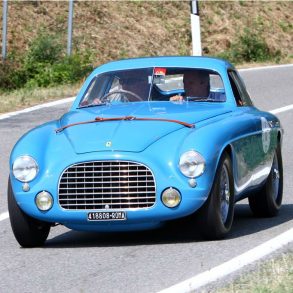
Ferrari 195 S
Year: 1950
Engine: 2.3 L Colombo V12
Predecessor: 166 MM
Successor: 212 Export
The 195 S was a sports prototype produced by Ferrari in 1950. Like many of the early Ferrari's only a few were ever made. The 195 S came with both a open top convertible and coupé versions. The two cars, one open and one closed coupe, shared that car's 2250 mm (89 in) wheelbase but sported an enlarged 2.3 L (2341 cc/142 in³) version of the Colombo V12. Learn More
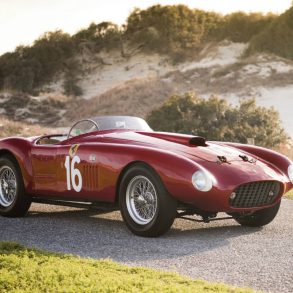
Ferrari 275 S
Year: 1950
Engine: 3.3 L Colombo V12
Predecessor: 340 America
Successor: 340 Mexico/MM
The new 3.3 liter Lampredi V12 engine got its first job powering the 275 S sports car. Two models were built with Touring barchetta bodies. This 275 S was the first Ferrari to retain the upcoming Lampredi V12 and in 1950 this car raced alongside the only other 275 S in the Millia Miglia. It did not finish. A year later, engine and mechanicals updated to 340MM spec. Learn More
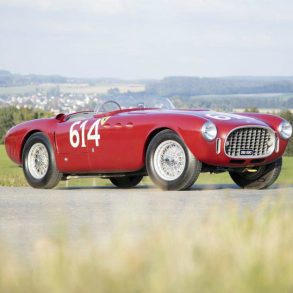
Ferrari 340 America
Year: 1950
Engine: 4.1 L Colombo V12
Predecessor:
Successor:
A study of the ‘America Ferraris’ starts with the type 340 America and continues with the 342/375 Americas. The first 340 Americas are competition cars and chassis 0082A claims the 1951 Mille Miglia victory. Since the 100 or so cars have individual specs, appointments and styling to suit a particular customer or racetrack, the Americas present a very diverse group. Learn More
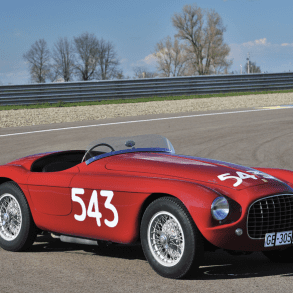
Ferrari 212 Export
Year: 1951
Engine: 2.6 L Colombo V12
Predecessor: 195 S
Successor: 225 S
Being a dual purpose car, the 212 was built in two distinct states of tune. For the serious enthusiasts, 27 examples called the Export model were built for racing in the GT and sports classes. In the 1950s, the 212 Export became the racer of choice for premier events such as the Tour de France, Mille Miglia and Carrera Panamerica. It won the Tour de France in 1951. Learn More
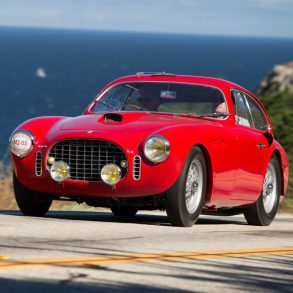
Ferrari 250 S
Year: 1952
Engine: 3.0 L Colombo V12
Predecessor: 225 S
Successor: 250 MM
Ferrari prepared the 250 Sport as a factory race car for the 1952 Season. The sole car debuted at the 1952 Mille Miglia where Giovanni Bracco and Alfonso Rolfo piloted it to outright victory. During the Mille Miglia, Ferrari was up against the recently-released 300 SL from Mercedes-Benz. Learn More
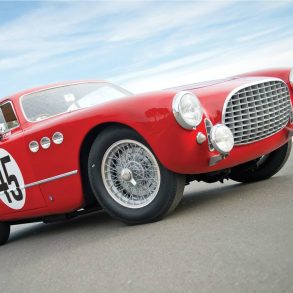
Ferrari 225 S
Year: 1952
Engine: 2.7 L Colombo V12
Predecessor: 212 Export
Successor: 250 S
The 225 Sport was introduced at the 1952 Giro di Sicilia as a larger version of 212 Export. This model was intended for endurance sports car racing and was bodied either as a two seat Berlinetta or Spyder, typically by Ghbia. Primarily sold to privateers while larger cars were raced by factory. Learn More
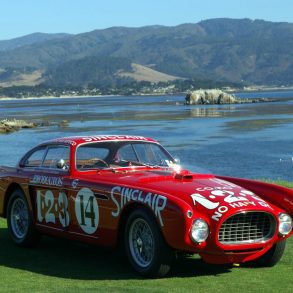
Ferrari 340 Mexico
Year: 1952
Engine: 4.1 L Colombo V12
Predecessor:
Successor: 340 MM
For the 1952 Carrera Panamericana, Ferrari produced three special coupes called the 340 Mexico. They took on the well-prepared Mercedes-Benz team which used the potent 300SL. In Mexico, the Ferraris were raced under the Franco Cornacchia’s Scuderia Guastalla banner. Learn More
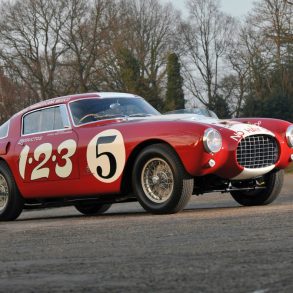
Ferrari 250 MM
Year: 1953
Engine: 3.0 L Colombo V12
Predecessor: 250 S
Successor: 250 Monza, 250 GT
The 250 MM was first displayed at the Paris Auto Show and was intended purely as a competition machine. It was a slightly updated version of the sole Ferrari 250 Sport which ran to victory at the 1952 Mille Miglia. At the heart of the 250 MM was a 2953cc V12. Bodies were by Pinin Farina only. Learn More
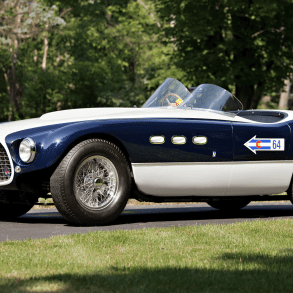
Ferrari 340 MM
Years: 1953
Engine: 4.1 L Colombo V12
Predecessor: 340 Mexico
Successor: 375 MM
After the 340 Mexico came Ferrari’s 340 MM which helped Giannino Marzotto and Marco Crosara win the 1953 Mille Miglia. They were piloting chassis 0280AM, a red 340 MM with race number 547. Under the hood different carburetion helped the 340 achieve 300 hp, some 20 more than its Mexico counterpart. Learn More
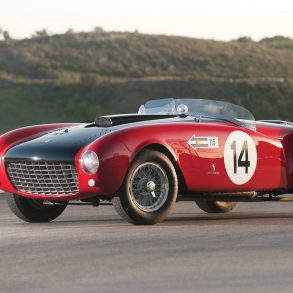
Ferrari 375 MM
Years: 1953
Engine: 4.5 L Colombo V12
Predecessor: 340 MM
Successor: 375 Plus
Built for the 1953 24 Hours of Le Mans, the type 340/375 combined the Mille Miglia-winning 340 chassis with Ferrari’s F1 V12 engine. It was Ferrari’s weapon of choice for many endurance sports car races. The 4.5-liter engine was taken straight out of the defunct F1 program. Called the Tipo 102, around 340 bhp possible. Learn More
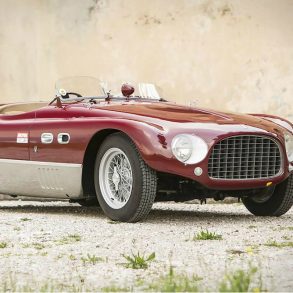
Ferrari 625 TF
Years: 1953
Engine: 2.5 L Lampredi I4
Predecessor: 250 MM
Successor: 500 Mondial
Of the three models built, a spider version driven by Mike Hawthorn took fourth position in the Grand Prix at the Autodromo in Monza in June 1953. Probably only three 625 TFs were made and at some point these may have been fitted with 3.0-liter engines (not sure). All the cars featured lightweight aluminum bodies from Vignale. Learn More
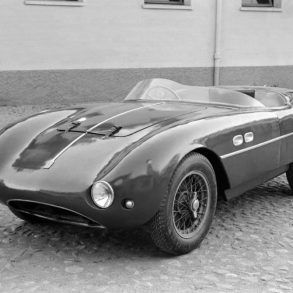
Ferrari 735 S
Years: 1953
Engine: 2.9 L Lampredi I4
Predecessor: 250 MM
Successor: 750 Monza
The Ferrari 735 S was built in 1953 with the aim of experimenting with new designs to succeed in competition. The Ferrari 735 S differs from other similar Ferrari by its small size, low weight and a 4-cylinder engine. Only 3 735 S were made, all used in competitions. The 3-liter 735 S Monzas were very successful. Learn More
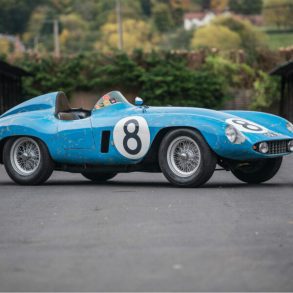
Ferrari 500 Mondial
Year: 1953
Engine: 2.0 L Lampredi I4
Predecessor: 625 TF
Successor: 500 TR
Reserved for Ferrari’s private customers, the Mondial was designed for events like the Targa Florio and the Mille Miglia were it could dominate the 2.0 liter class. It was named after Alberto Ascari’s domination in the Formula 2 World Championship and like the single seat race cars, used an four cylinder engine. Learn More
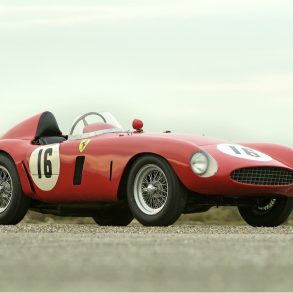
Ferrari 750 Monza
Year: 1954
Engine: 3.0 L Lampredi I4
Predecessor: 735 S
Successor: 857 S
One of the prettiest Ferrari racers ever is the 750 Monza. The 750 Monza prototype made its debut in 1954 at Monza with an engine based on a development of the Type 555. The 3.0-liter, four-cylinder, double overhead cams and had 250 horsepower. Took both 1st and 2nd in inaugural race. Learn More
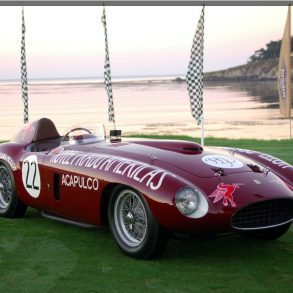
Ferrari 250 Monza
Year: 1954
Engine: 3.0 L Colombo V12
Predecessor: 250 MM
Successor: 857 S, 250 TR
The 250 Monza is a great example of how Ferrari engineered different cars for specific clients and tracks. One of the first appearances of the 250 Monza was at the Monza Autodromo on June 27th, 1954. During this race, this very car, chassis 0442, placed third with Franco Cornacchia and Guerino Gerini at the wheel. Learn More
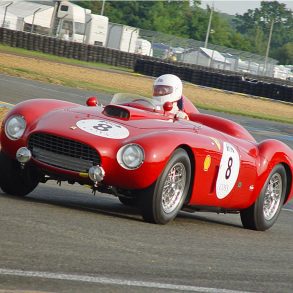
Ferrari 375 Plus
Year: 1954
Engine: 5.0 L Lampredi V12
Predecessor: 375 MM
Successor: 410 S
By 1954, Ferraris large displacement V12 had already won at the top level of motorsport. Ferrari continued to use the engine in road racing cars which started with the 340 America and continued with the successful 375MM which was upgraded in 1954 to become the 375 Plus. It was a more potent derivative that won LeMans. Learn More
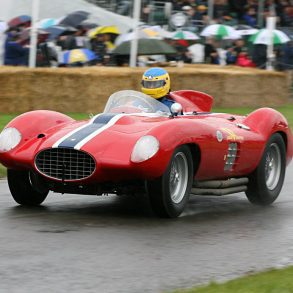
Ferrari 118 LM
Year: 1954
Engine: 3.7 L Lampredi I6
Predecessor: 750 Monza
Successor: 735 LM
Bodied by Scaglietti the new cars were officially known as the 376 S and 446 S respectively, but the names were changed to 118 LM and 121 LM. Three of both were constructed, but halfway through the 1955 season one of the 118 LMs was upgraded by the factory to 121 LM specifications. The first serious race for the new cars was the Buenos Aires 1000 km race, where a single 118 LM was entered by the works backed up by seven privateers.
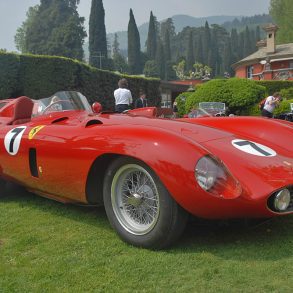
Ferrari 121 LM
Year: 1955
Engine: 4.4 L Lampredi I6
Predecessor: 376 S
Successor: 625 LM
The Ferrari 121 LM was powered by a six-cylinder engine. The result was the 306. The '306' was really just a developmental car. The results were the Type 118 and Type 121. Type 121 was a larger 4.4-liter unit, known as the 446 S, and it too powered Ferraris constructed by Scaglietti. Names 376 S and 446 S were later changed to the 118 LM and the 121 LM. There were three versions of both constructed. Learn More
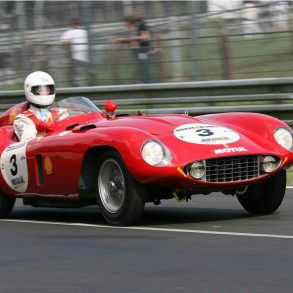
Ferrari 376 S
Year: 1955
Engine: 3.7 L Lampredi I6
Predecessor: 750 Monza
Successor: 735 LM
The Ferrari 376 S (also known as the 118 LM) was a sports racing car produced by Ferrari in 1955. It was the first raced Ferrari powered by a new Aurelio Lampredi-designed inline-6 engine, created as a larger alternative to the inline-4 series of engines used in the Ferrari Monza race cars. This is the very first sports car with a six-cylinder in-line engine, although another three-litre 306 engine was also been built but never used.
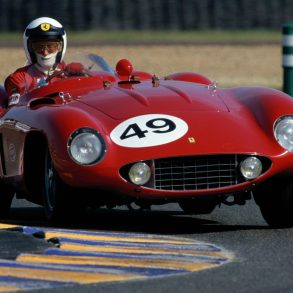
Ferrari 735 LM
Year: 1955
Engine: 4.4 L Lampredi I6
Predecessor: 376 S
Successor: 625 S
The first six-cylinder cars raced at the 1955 Buenos Aires 1000km. Known as the 376 S, 280 bhp was possible from the 3.7-liter. After Trauffi won the Giro de Siclia, the cars were outfitted with a 4.4-liter engine. Called the Tipo 121, the 4.4-liter engine was capable of 360 bhp. Fed by 58mm Weber carburetors, three of these engines were fitted into cars for the 1955 season, becoming known as the 735 LMs. Learn More
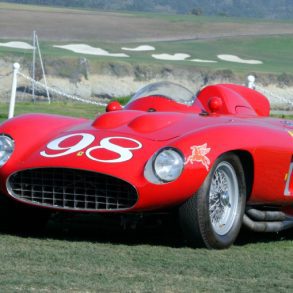
Ferrari 857 S
Year: 1955
Engine: 3.4 L Lampredi I4
Predecessor: 750 Monza
Successor: 860 Monza
The short-lived 857 S of 1955 was an attempt to hold off the strong Mercedes-Benz team, something the 750 Monza and the 376 S/735 LM were unable to do. An existing 750 Monza chassis received an enlarged version of Lampredi's four, now displacing 3.4 L. The car was not competitive at the 1955 Tourist Trophy, so Lampredi went back to the drawing board.

Ferrari 500 TR
Year: 1956
Engine: 2.0 L Lampredi I4
Predecessor: 500 Mondial
Successor: 860 Monza
As the 750 was introduced in 1954, the smaller 500 Mondial was replaced by another two-liter car, the 500 TR. The first car to bear the famed Testa Rossa name, the 500 TR differed from the Mondial in many details. Among the most important was a coil spring suspension, a radical departure for Ferrari, as well as a synchronized transmission with a two-disc clutch.
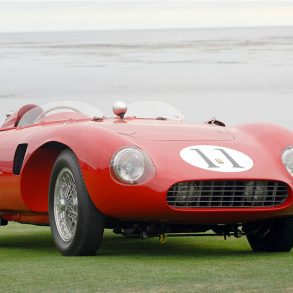
Ferrari 625 LM
Year: 1956
Engine: 2.5 L Lampredi I4
Predecessor: 735 LM
Successor: 335 S, 250 TR
After the 1955 Le Mans disaster, the ACO reduced engine size and restricted prototype entries for the 1956 24 Hours of Le Mans to control the speed and danger of the race. Ferrari could not enter its 1956 3.4 L 860 Monza and 3.5 L 290 MM in race, so it instead modified three 500 TR barchettas to take the larger 2.5 L engine, and entered them as the 625 LM.
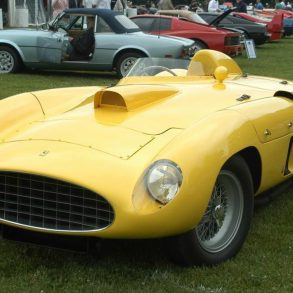
Ferrari 410 S
Year: 1956
Engine: 5.0 L Lampredi V12
Predecessor: 375 Plus
Successor: 290 MM
The 410 S was intended as a long distance race car originally designed for the 1955 Carrera Panamericana and was the final model of the Lampredi V12 sports car lineage. The next generation of sports racing cars that replaced the 410 S were powered by the new Jano V12 engines. The Ferrari 410 S was created as an evolution of the 375 Plus that preceded it. Learn More
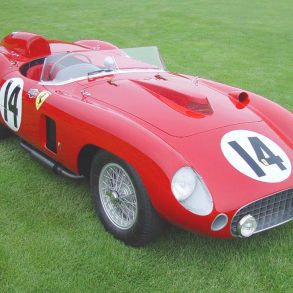
Ferrari 290 MM
Year: 1956
Engine: 3.5 L Jano V12
Predecessor: 410 S, 860 M
Successor: 290 S
The 290 MM was produced as a factory competition car in a transition period for Ferrari. Designed for the 1956 Mille Miglia and as a replacement for the 860 Monza, the 290MM was mounted with a V12 engine with dual ignition and dry sump derived from the 4.5-litre Grand Prix car. Purpose-built Ferraris were dominant at events like the Mille Miglia and it won outright in 1956. Learn More
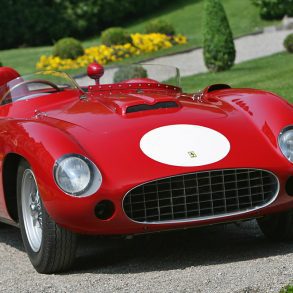
Ferrari 860 Monza
Year: 1955
Engine: 3.4 L Lampredi I4
Predecessor: 857 S
Successor: 290 MM
Inspired by the F1 program, and the ALTA four-cylinder engine, Ferrari built three large-displacement, 4-cylinder prototypes known as the 860 Monza. These were used in the 1956 season as factory competition cars alongside the V12 290 MM. The first two Monzas appeared at the 1956 Twelve Hours of Sebring and were entered for Scuderia Ferrari. Learn More
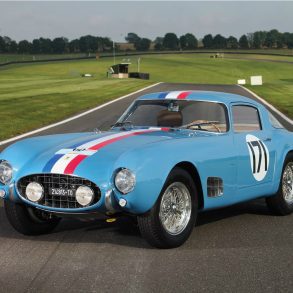
Ferrari 250 GT Berlinetta “TDF”
Year: 1956
Engine: 3.0 L V12
Predecessor: 225 S
Successor: 330
The original 250 GT Berlinetta, nicknamed the "Long Wheelbase Berlinetta", was also called the "Tour de France" after competing in the 10-day Tour de France automobile race. Seventy-seven Tour de France cars were built. Construction was handled by Carrozzeria Scaglietti based on a Pinin Farina design. The engine began at 237 hp but eventually rose to 256 hp.
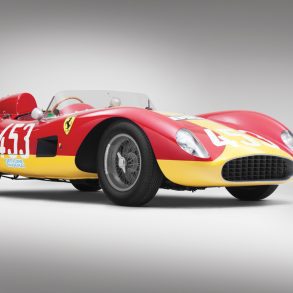
Ferrari 500 TRC
Year: 1957
Engine: 2.0 L Lampredi I4
Predecessor: 500 TR
Successor:
The 500 GTC was built to keep the Ferrari 500 Testa Rossa up to date with the 1957 Appendix C sports car regulations. It used an updated version of the Ferrari’s inline four and chassis revisions which distinguished it from the preceding model. Changes to the body included a full-width windscreen and functioning doors. The engine was designed by Lapredi to a 2-liter. Learn More
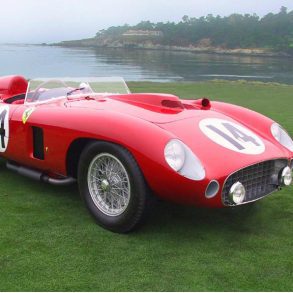
Ferrari 290 S
Year: 1957
Engine: 3.5 Jano V12
Predecessor: 290 MM
Successor: 315 S
The Ferrari 290 S was a development of an earlier 290 MM race car that won the 1956 Mille Miglia. The 290 S was the first sports car manufactured by Ferrari to be powered by a DOHC V12 engine. Its career was very short but it served as an important milestone in the Jano V12-powered lineage.
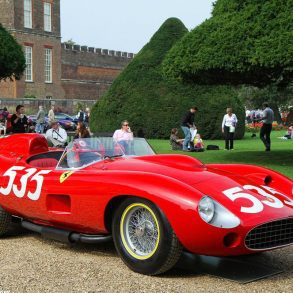
Ferrari 315 S
Year: 1957
Engine: 3.8 L Jano V12
Predecessor: 290 S
Successor: 335 S
Fitted with a V12 with four chain-driven overhead camshafts, the 315 S was an update to the single camshaft engine. In addition to being more powerful, the engine was also twenty pounds lighter and more reliable. Built as an evolution of the 290 S it was Ferrari’s answer to a horsepower threat. Learn More
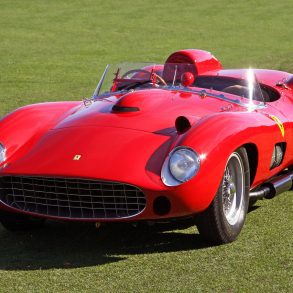
Ferrari 335 S
Year: 1957
Engine: 4.0 L Jano V12
Predecessor: 315 S
Successor: 250 TR
The Ferrari 335 S was a sports racing car produced by Italian manufacturer Ferrari in 1957. The car was a direct response to the Maserati 450S which with its 4.5-litre engine was threatening to overpower the 3.8-litre 315 S and 3.5-litre 290 MM. Four cars were produced in total. Learn More
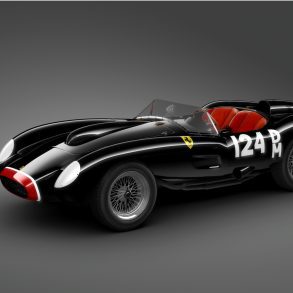
Ferrari 250 Testa Rossa
Year: 1957
Engine: 3.0 L Colombo V12
Predecessor: 500 TR
Successor: 250 P
Introduced at the end of the 1957 racing season in response to rule changes that enforced a maximum engine displacement of 3 liters for Le Mans and World Sports Car Championship races. The 250 TR was closely related to earlier Ferrari sports cars, sharing many key components with other 250s and the 500 TR. Learn More
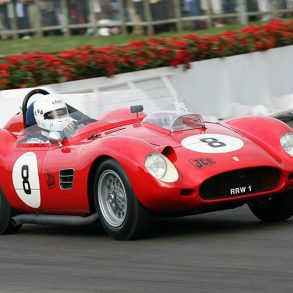
Ferrari Dino 196 S
Year: 1958
Engine: 2.0 L Dino V6
Predecessor:
Successor:
The Ferrari 196 Dino was the first Ferrari sports car to receive the V6 engine. Essentially the new V6 resembled half a V12 at a 1.9-liter capacity. The 196 Dino was briefly raced by the factory with little success. It was also the only Ferrari sports car that used the Dino V6 in the front of the car. A similar car, the 196 SP was released in 1961. It featured the same engine in the rear of the car. Learn More
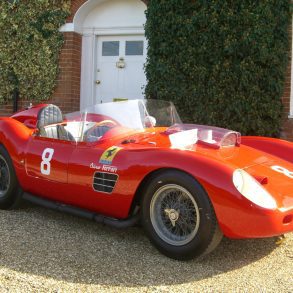
Ferrari Dino 296 S
Year: 1958
Engine: 3.0 L Dino V6
Predecessor:
Successor:
At Silverstone's over-1500cc race, Ferrari brought out their V6 Testa Rossa 'replacement'. Known as the Dino 296S this three-liter V6 had 300 bhp and looked promising-but this was only in specification. Driver Mike Hawthorn recalled it was 'catching up everyone on the straight, only to lose it again on the corners.' He was dealing with excessive over steer, roll and cornering issues. Learn More
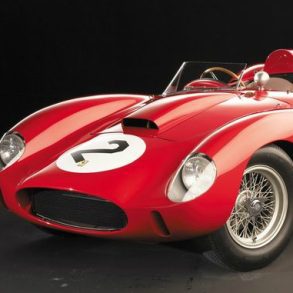
Ferrari 312 S
Year: 1958
Engine: 3.0 L Jano V12
Predecessor: 335 S
Successor:
The Ferrari 312 S was an experimental prototype sports car, created in 1958 by Ferrari to comply with 3.0-litre cap imposed after the tragic 1957 Mille Miglia events. Only one chassis was ever built, s/n 0744. It was powered by a new 3.0-litre Tipo 142 Jano V12 engine with twin overhead camshafts per bank. The car was modified, reengined and renamed as the 412 S.
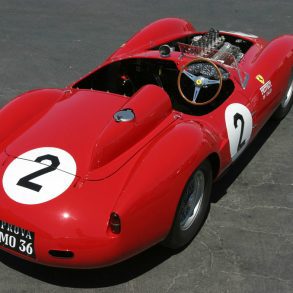
Ferrari 412 S
Year: 1958
Engine: 4.0 L Jano V12
Predecessor: 312 S
Successor:
The 412 S combined Ferrari's most powerful V12 engine to date with a one-off experimental racing chassis. John von Neumann asked Ferrari to assembled this hot rod for American SCCA racing. The first outing was at Watkins Glen in 1958. Driven by Phil Hill, the car retired with mechanical problems and then sent back to factory and fitted with disc brakes. Learn More
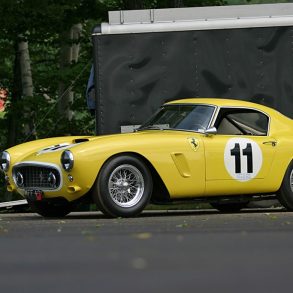
Ferrari 250 GT Berlinetta "SWB"
Year: 1959
Engine: 3.0 L Colombo V12
Predecessor: 225 S
Successor: Cali Spyder SWB
At the 1959 Paris Salon, Ferrari introduced the short-wheel-base (SWB) Berlinetta as a competition car. Strictly a race car, the first versions of the SWB featured an all-aluminum body. In 1960 Ferrari introduced their Touring model, sometimes call Lusso, which had larger-diameter frame tubes, a full interior and a steel body. Competition models were produced up until 1962 with minor updates. Learn More
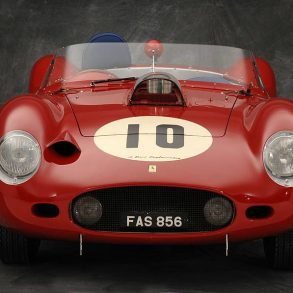
Ferrari Dino 246 S
Year: 1958
Engine: 3.0 L Dino V6
Predecessor: 296 S Dino
Successor: 246 SP
The Dino V6 debuted in 1957 for the 1.5-liter Formula 2 Championship and was enlarged in 1958 for F1. The Goodwood car used an engine similar to the Formula One engine and was known as the ‘246 S’. It was a 2-liter version of the quad-cam V6 engine that was bored at 77mm to have 1983cc displacement and 225 bhp @ 8500 rpm. By 1961, the V6 cars were dated vs new mid-engine counterparts so the focus went to the 246 SP. Learn More
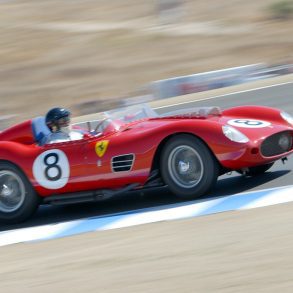
Ferrari 250 TR59
Year: 1959
Engine: 3.0 L Colombo V12
Predecessor: 500 TR
Successor: 246 SP
Before the start of the 1959 season, Ferrari sold off the TR58s and chief designer Carlo Chiti prepared an even more radical car for the year ahead – the TR59. Five newly engineered TR59s appeared over season with striking Pininfarnia-designed bodies. The result was a lower and smaller Testa Rossa that incorporated many new elements, including front brake ducts and a clear plastic intake duct over the carburetors. Learn More
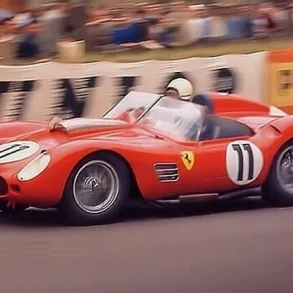
Ferrari 250 TR59/60
Year: 1960
Engine: 3.0 L Colombo V12
Predecessor: 500 TR
Successor: 246 SP
After narrowly losing the 1959 World Sports Championship to Aston Martin, things had to change and Ferrari updated the TR59 into the TR59/60. 1959 cars that were updated to 1960 spec (minus independent rear suspension) are often designated as 250 TR59/60. The Testa Rossa needed a tighter turning radius, a larger windscreen, windshield wipers and a trunk space. These changes distinguished the TR59/60 from TR59. Learn More
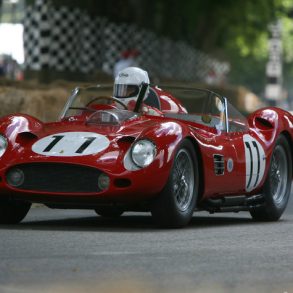
Ferrari 250 TRI60
Year: 1960
Engine: 3.0 L Colombo V12
Predecessor: 500 TR
Successor: 246 SP
Before Le Mans and in the middle of the season, Carlo Chiti adapted the Formula One rear suspension to the Testa Rossa, but kept the outboard rear discs and front-mounted barrel-type gearbox. It had double wishbones, the suspension that was fully independent. It included an upgraded 5-speed transmission, vented disc brakes and a slight weight reduction. The new car was called the TRI60 and looked outwardly identical to the TR59/60 it was built from and usually raced beside. Learn More
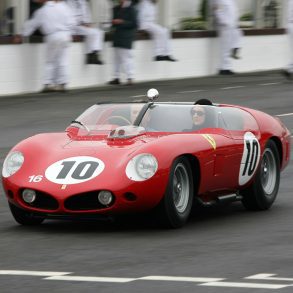
Ferrari 250 TRI61
Year: 1961
Engine: 3.0 L Colombo V12
Predecessor: 500 TR
Successor: 246 SP
Built to maintain Ferrari’s dominance in sports car racing, the TRI61 was Ferrari’s best and most developed weapon. It belonged to an evolving series of Testa Rossas which, by 1961, had already won many important endurance races and international championships for Ferrari. Development meant the TRI60 included all-enveloping bodies, disc brakes, magnesium castings and an independent rear suspension. New for 1961 was twin-nostril body that had a taller, more cut-off rear end. Learn More
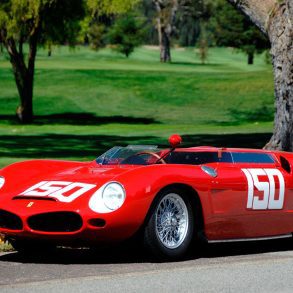
Ferrari 246 SP
Year: 1960
Engine: V6
Predecessor: Dino 246 S
Successor: P / Dino 166 P
In 1960, the Ferrari’s first mid-engine, sports prototype was released. The defining feature of the car was it’s Dino V6 engine which was mounted in the rear of the car. The 246 SP featured a punched out version of the Dino, 1.5-liter V6, originally developed for Formula racing. Due to the short length of the Dino engine, it was a suitable size to fit in the rear of the prototype cars. Alongside the front-engine Testa Rossa, two 246 SPs raced throughout 1960. The first finish was achieved at the Targa Florio. Learn More
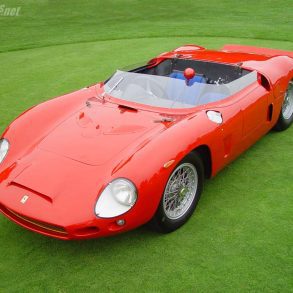
Ferrari 196 SP
Year: 1962
Engine: V6
Predecessor: Dino 246 S
Successor: P / Dino 166 P
As the 246, 248 and 268 models matured and were being replaced by cars such as the 250 P, most of the old mid-engine chassis received a Dino V6. With this setup the cars were sold to semipro drivers who ran the cars in two liter endurance and hill climb racing. The 196 SP did not have a Dino engine, but was effectively a half of the 330’s V12 engine, from which it retained the bore and stroke. The 196 SP boasted the twin front air intakes first introduced on the single-seaters in 1961. Learn More
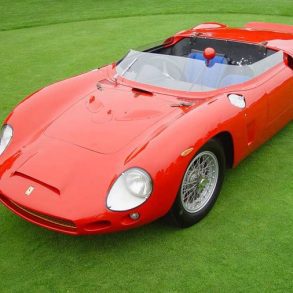
Ferrari 286 SP
Year: 1962
Engine: V6
Predecessor: Dino 246 S
Successor: P / Dino 166 P
The Ferrari 286 SP was the second model to make its debut at the 1962 press conference and was similar to the 196 SP. Like the 196 SP and the revised 1962 246SP, it had revised bodywork with a redesigned windscreen and tail to comply with new regulations. Only one example was produced, but never raced. S/n 0802 was presented to the press in February and converted into the 268 SP by May that year. Learn More
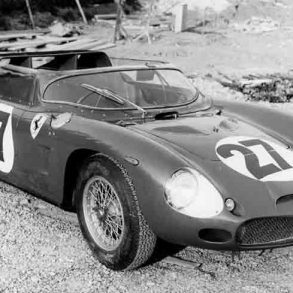
Ferrari 248 SP
Year: 1962
Engine: V8
Predecessor: Dino 246 S
Successor: P / Dino 166 P
The 248 SP was built around a new Ferrari V8. With a new crankshaft, displacement was increased resulting in the 268 SP. This 2,458 cc barchetta was fitted with a single overhead camshaft V8 engine fed by four twin-choke Weber carburettors good for around 250 bhp. The tubular space-frame featured all-round independent suspension while the bodywork was very similar to the 246 SP’s. Learn More
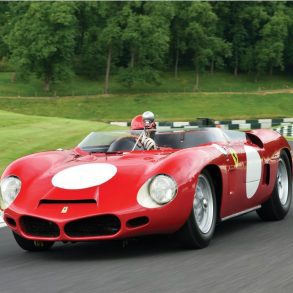
Ferrari 268 SP
Year: 1962
Engine: V6
Predecessor: Dino 246 S
Successor: P / Dino 166 P
The 268 SP version was also fitted with a V8 engine, with the stroke increased to 71 mm and upped to 2,650 cc. The tubular space-frame featured all-round independent suspension while the bodywork was very similar to the 246 SP’s, a unique and dramatic barchetta design created by Fantuzzi coachwords. It had a low windscreen, curved rear fenders and a sharp, creased spoiler at the edge of the tail. Learn More
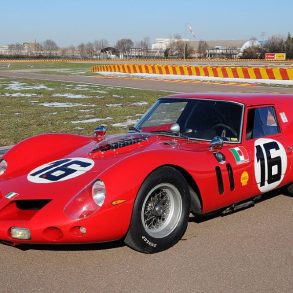
Ferrari 250 GT SWB Breadvan
Year: 1962
Engine: V12
Predecessor:
Successor:
Even today, chassis 2819GT is still referred to as the Breadvan. To see it is a rare, unusual and exciting sight. It is a one-of, and of all the modified Ferrari’s, it has to be the most notorious. Developed by ex-Ferrari personnel and raced by a team that was refused sale of the car they wanted most, the 250 GTO. At the time, Enzo Ferrari must have been particularly perturbed. Learn More
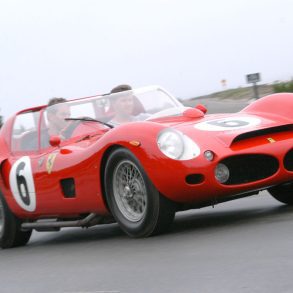
Ferrari 330 TRI/LM
Year: 1962
Engine: 4.0 L Tipo 163 V12
Predecessor: 250 TRI60
Successor: 250 P
As raced at LeMans, the 330 TRI/LM was the last in a long running and highly successful series of Ferrari Testa Rossas. In this regard, it was the most developed and benefited from all the versions which came before it. But, our feature car also has the distinction of being a unique prototype that won at LeMans. After the 1962 season, and their victory at LeMans, Ferrari retired the Testa Rossas, replaced by the 250P, Ferrari’s first prototype with a midship V12. Learn More
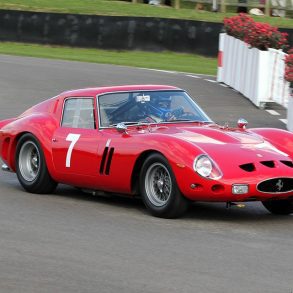
Ferrari 250 GTO
Year: 1962
Engine: 3.0 L Tipo 168 V12
Predecessor: 250 GT SWB
Successor: 250 LM
With the GTO, “Ferrari completely decimated the opposition in the first year of competition. ” and scored maximum points in 1962 Division III Championship for sports cars over two liters. During the fifth round at the 24 Hours of Le Mans, GTOs placed second and third overall behind the winning Ferrari 330 TRI/LM. This was a remarkable result and proved that the GTO could beat many cars in the prototype category. The best ever? Maybe. Learn More
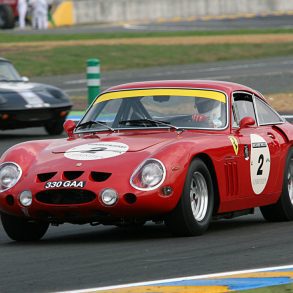
Ferrari 330 LMB
Year: 1963
Engine: 4.0 L Tipo 163 V12
Predecessor: 250 TRI60
Successor: 250 P
For the 1963 24 Hours of Le Mans Ferrari prepared four 4-liter prototypes known as the Le Mans Berlinetta (LMB). These were largely based off the successful 1962 330 GTO with revised rear bodywork. Four 330 LMB GT racing cars (with LMB standing for Le Mans Berlinetta) were built in 1963. This model is also known as the 330 LM. The 330 LMB did not see much racing, as Ferrari was moving over to the mid-engined layout for racing. Learn More
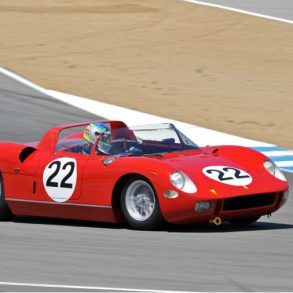
Ferrari 250 P
Year: 1963
Engine: 3.0 L V12
Predecessor: 330 LMB
Successor: 275 P, 330 P
In 1963 Ferrari released a prototype which was essentially a 250 LM minus the roof. Therefore it shared the model’s mid-mounted V12 engine and tubular space frame but had a slightly more advanced body shape. The 250 P didn’t take long to establish its name on the track. Afterward the cars were used in Europe at many rounds of the World Sportscar Championship. Only one 250 P was used at the Targa Florio in May and failed to finish. Learn More

Ferrari 250 GTO '64
Year: 1964
Engine: 3.0 L Tipo 168 V12
Predecessor: 250 TRI60
Successor: 250 P
In 1963 steps were made to improve the first GTO, including an all-new Pininfarina-designed body. The new Pininfarina design was both lower and wider than the original GTO. Sometimes referred to as the Series II or ’64 GTO, only three examples originally received the new body. The engine for the ’64 GTO retained the familiar Tipo 168/62 V12. Slight modifications included different tuning for the Weber carburetors and smaller exhaust manifolds. Learn More
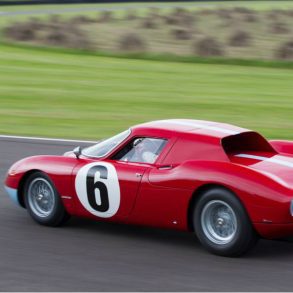
Ferrari 250 LM
Year: 1964
Engine: 3.3 L V12
Predecessor: 250 P
Successor:
At the 1965 LeMans, Ferrari’s 250LM sports car fulfilled its purpose by winning the race it was named after. Drivers Jochen Rindt and Masten Gregory had much to celebrate since it was the 250LM’s greatest moment as well as their own. They were piloting Ferrari’s ideal sports-racing car which had the the successful hallmarks of the mid-1960s design with a mid-mounted V12 engine in a low-drag body. The 250LM was a Ferrari 250 P with a roof. Learn More
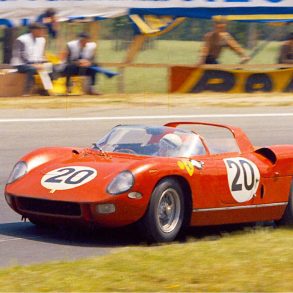
Ferrari 275 P
Year: 1964
Engine: 3.3 L V12
Predecessor: 250 P
Successor:
Another addition to the long and hugely successful P series which began with the 250 P. Naturally enough, the 275 P refers to the unitary displacement and the letter P to the fact that this is a prototype. The increase in displacement was sought to improve performance and reliability over the distances involved in endurance races. The engine was also used in the 250 LM series after the FIA turned down its type approval as a GT car. Learn More
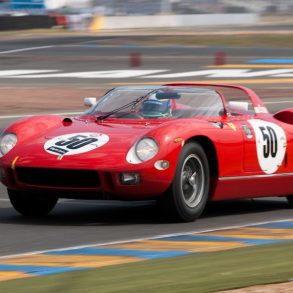
Ferrari 330 P
Year: 1964
Engine: 4.0 L Colombo V12
Predecessor: 250 P
Successor:
For the 1964 season, Ferrari developed the 275 P and 330 P. These were improved versions of the 250 P with larger displacement engines and slightly modified bodywork. The 330 P used a different engine than the 275 P, a 4.0L Colombo-designed V12 based on engines used in the 400 Superamerica road cars. The 330 P developed more power than the 275 P (370 bhp vs 320 bhp) but weighed more (785 kg vs 755 kg). A great race car. Learn More
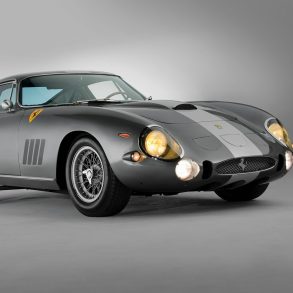
Ferrari 275 GTB Competizione
Year: 1965
Engine: 3.3 L Tipo 213 V12
Predecessor:
Successor:
After Ferrari needed a competition version of the 275 in motor sports, aluminum-bodied variants known as the ‘Cliente Competizione’ began to be produced. Ferrari built a second series of 275 GTB competition cars simply known as the GTB/C. Ferrari reconsidered the 275 from the day it was launched because the 250 LM was denied homologation. They fit the 275 with competition engines and aluminum bodies for their race clientele. This resulted in a tremendous class victory at the 1966 24 Hours of Le Mans. Learn More
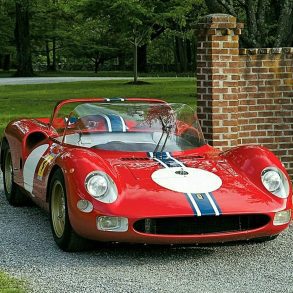
Ferrari 275 P2
Year: 1965
Engine: 3.3 L V12
Predecessor: 275, 330
Successor: 330 P3
Two entirely new cars, the 275 P and P2 were specially designed Ferraris with the specific goal of capturing the World Championship, and more importantly to beat Ford. Both cars were mid-engined, open-topped cars. The P2 cars were replaced by the P3 for 1966. The 275 P was powered by a 3.3-liter powerplant; a 4 and 4.4 liter version were also used. These mid-engined, open-topped cars were comprised of many of the same components as the road-going versions. Won the 1000km of Monza and Targa Florio. Learn More
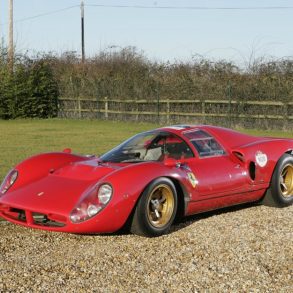
Ferrari 330 P2
Year: 1965
Engine: 3.3 L V12
Predecessor: 275, 330
Successor: 330 P3
The P2 was specially designed Ferraris with the specific goal of capturing the World Championship. Featuring lower and lighter chassis and more aerodynamic body, the 330 P2 was paired with a revamped version of the previous 330 V12, now equipped with four camshafts and producing 410 hp. The 330 P2 was first used by Luigi Chinetti's North American Racing Team (NART) in the Daytona race that year. The 330 P2 0828 won the Nurburgring 1000 km. The P2 cars were replaced by the P3 for 1966. Learn More
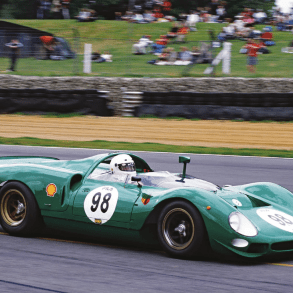
Ferrari 365 P2
Year: 1965
Engine: 4.4 L V12
Predecessor: 250 LM
Successor:
At the time, the 365 P2 was the ultimate version of the Ferrari 250LM. It shared the car’s basic spaceframe chassis and overall shape. From year to year, the body design was upgraded. Regulations in 1965 meant that the front windscreen had to be unnecessarily tall and gave the P2 Ferraris a distinct appearance. The car was basically intended for the 1965 24 Hours of Le Mans where two cars were entered by Maranello Concessionaires and the NART. It couldn't bear the 250 LM. Learn More
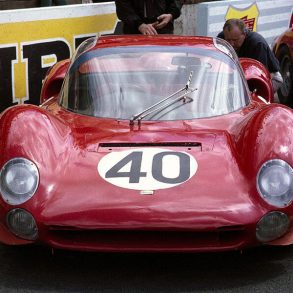
Ferrari Dino 166 P
Year: 1965
Engine: 1.6 L Dino V6
Predecessor: SP
Successor: 206 P
The 1965 Dino 166 P was created by Ferrari to compete in endurance racing with categories up to 1600 cc or even 2000 cc. After a failed attempt at the 1000km Monza in May 1965, the following month the 166 P was entered into the GP Roma on the Vallelunga track. Giancarlo Baghetti won it outright, two laps ahead of a Porsche. Learn More
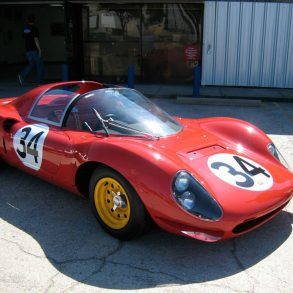
Ferrari Dino 206 SP
Year: 1965
Engine: 2.0 L Dino V6
Predecessor: 166 P
Successor: 206 SP
The Dino sports prototype model that followed the 166 P was the Dino 206 SP. The first example was an exact conversion from is predecessor, but now with the new barchetta body and bigger 2.0 liter engine. All of the chassis and suspension configuration was carried over without change. The new bodywork was 6.3 inches lower. Learn More
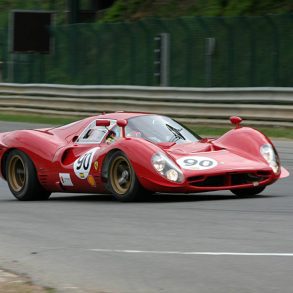
Ferrari 330 P3
Year: 1966
Engine: 3.3 L V12
Predecessor: 330 P2
Successor: 330 P4
The 330 P3 was the next development of the 330 P2. It was almost entirely the same car as the P2 except for minor details such as the Lucas fuel injection system and ZF, 5-Speed transmission. Featured a new tubular chassis with a fibreglass tub, with engine and gearbox an integral part of the structure, enhancing its rigidity. Learn More
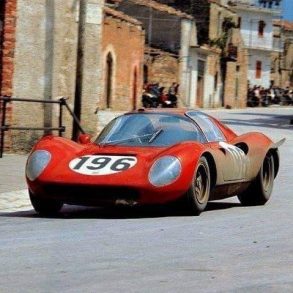
Ferrari Dino 206 S
Year: 1966
Engine: 2.0 L Dino V6
Predecessor: 206 SP
Successor:
The last of the Dino prototype sports car models was produced in 1966–1967. 18 examples were made with Group 4 category homologation in mind. Still powered by 2.0 L (1,986.60 cc (121.2 cu in)) engine based on the 206 SP powerplant. Some received experimental 3-valve heads and Lucas fuel injection. Learn More
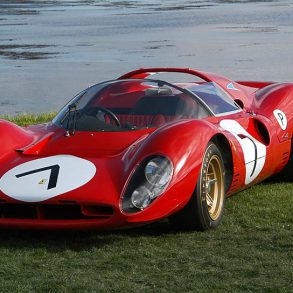
Ferrari 330 P4
Year: 1967
Engine: 4.0 L Type 237 V12
Predecessor: 330 P3
Successor:
One of the most revered Ferraris is the 330 P4. It is curvaceously low lines and a sleek, yet aggressive. Only one completely original car remains. It raced alongside both the 330 P3 which was an earlier evolution of the car, and the 412P which was a much less complicated version of the P4. The last prototypes that looks like a sports car. Learn More
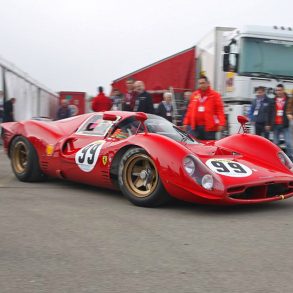
Ferrari 412 P
Year: 1967
Engine: 4.0 L Type 237 V12
Predecessor: 330 P4
Successor:
The 412P was sold to private races teams as a much more manageable version of the 330 P4. The main difference was a carburetted version of the 330 engine that used two valves instead of three. The 412 also had a different chassis with a slightly shorted wheelbase. Two examples were converted from P3s to 412 P specification. Learn More
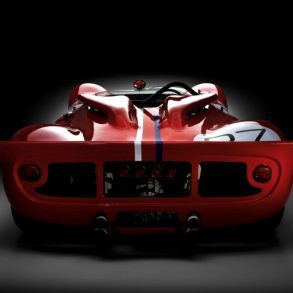
Ferrari 350 Can Am
Year: 1967
Engine: 4.2 L V12
Predecessor: 330 P4
Successor: 612 Can Am
After the Ferrari 330 P4s finished their duties in 1967, they were returned to the factory and two were converted for the Canadian-American Challenge (Can-Am). Even with their striking new body and enlarged engine, these spyders were no match for the competition in Group 7 and fell behind cars like the McLaren M6A-Chevrolet. Learn More
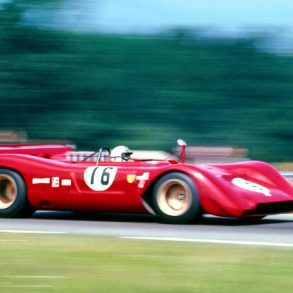
Ferrari 612 Can Am
Year: 1968
Engine: 6 L V12
Predecessor: 350 Can Am
Successor:
A second model was built for the Can-Am Challenge Cups series and was a more powerful version of its predecessor with the 612 referring, in fact, to its six-litre 12-cylinder engine. Finished just in time to take part in the last race of the season at Las Vegas. In 1969, it was represented at Watkins Glen where Chris Amon got 3rd. Learn More
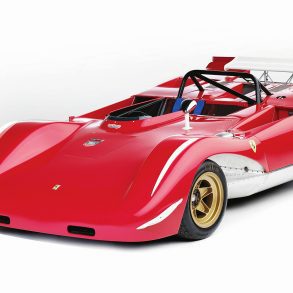
Ferrari 212 E
Year: 1969
Engine: 2.0 L V12
Predecessor: 1512
Successor: 312 PD
The Ferrari 212 E Montagna was a one-off spyder sports racing car produced by Ferrari in 1968. The car was built on a Dino 206 S chassis and used a unique 2-litre, 48-valve, flat-12 engine, a development of the 1512 1.5-litre Formula One engine. Driven by Peter Schetty, the car dominated the 1969 European Hill Climb Championship, placing first in every race it entered and setting many course records. Learn More
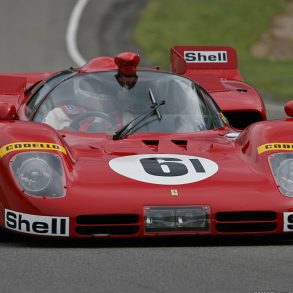
Ferrari 512 S
Year: 1970
Engine: 5.0 L V12
Predecessor: 330 P4
Successor:
In 1970 Ferrari began production of the 512 S to challenge the Porsche opposition. It was named after its 5-liter V12 engine and the Sport class which it raced in CSIA/FIA events. Unfortunately, the 512 was largely unsuccessful at upsetting Porsche dominance. Although the 512 was much better balanced, the updated 917 was much faster and could reach speeds of 245 mph. Only one victory was scored (Sebring). Learn More
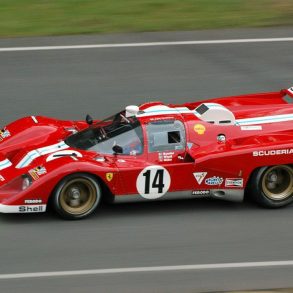
Ferrari 512 M
Year: 1970
Engine: 5.0 L V12
Predecessor: 512 S
Successor: 312 PB
Later that year, modified versions resembling their main competitor, the Porsche 917, were called Ferrari 512 M (for modificata). In the 1971 International Championship for Makes, the factory focused on the new Ferrari 312 PB and abandoned the 512 which was only entered by privateers. For speed tracks (Le Mans, Spa) an extra rear body panel designed to suit the 512. Learn More
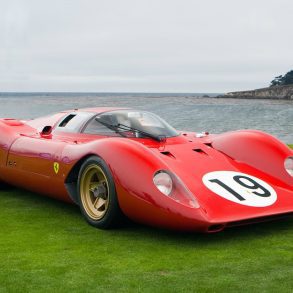
Ferrari 312 P
Year: 1969
Engine: 3.0 L V12
Predecessor: 330 P
Successor:
Ferrari boycotted sports car racing in 1968 to protest a rule change that banned Ferrari’s 4-liter 330 P4. Ferrari went ahead and downsized their approach, building a 3 liter prototype in 1969, calling it the 312 P. It was basically a 3-liter F1 engined Ferrari312 with open Barchetta body. Ferrari soon thereafter closed the top. The 3.0 liter V12 engine produced 450 bhp at 10,800 rpm. Learn More
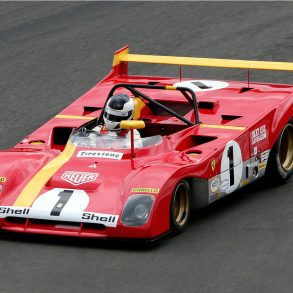
Ferrari 312 PB
Year: 1971
Engine: 3.0 L Flat 12
Predecessor:
Successor:
The Ferrari 312 PB was a Group 6 sports prototype racer from Ferrari. Introduced in 1971 it is actually designated the 312 P. Most people (including us) call it the 312 PB to avoid confusion with a previous car of the same name. It was part of the Ferrari P series of racers but was re-designated as a Group 5 Sports Car for 1972. Learn More
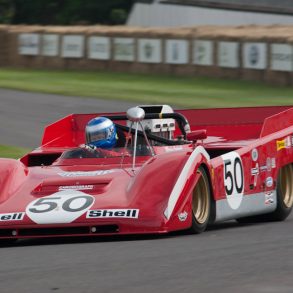
Ferrari 718 Can Am
Year: 1971
Engine: 7.0 L V12
Predecessor: 512 M
Successor:
The need for very high torque to cope with the torturous tracks of the Can Am series saw Ferrari build its biggest ever engine at around seven litres. This model was a one-off, developed from a modified 512 M which was fitted with the new engine at the factory. The car won on its debut at the Imola Interserie race on May 2 1971. Learn More
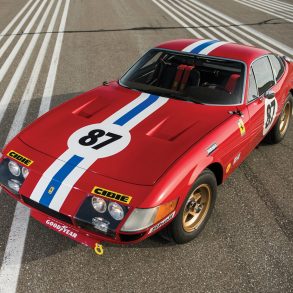
Ferrari 365 GTB/4
Year: 1972
Engine: 4.4 L Colombo V12
Predecessor:
Successor: 512 BB LM
Produced by Ferrari’s Assistenza Clienti department, the Ferrari Daytona was produced in 1971 to Group 4 specification for limited clients. During the inaugural year, only 5 of these cars were produced with aluminum body panels, plexiglass windows and a cold air induction system that raised power to 402 bhp. Learn More
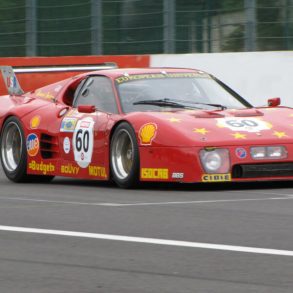
Ferrari 512 BB LM
Year: 1979
Engine: Flat 12
Predecessor: 365 GTB/4
Successor:
In 1974, Luigi Chinetti's North American Racing Team (NART) developed a racing variant of the 365 GT4 BB to replace the team's Daytonas for use in sports car racing. It didn't go well. After the failure of the first batch, Ferrari worked on fixing the BB LM with a second development program in late 1978, leading to the 512 BB LM. Learn More
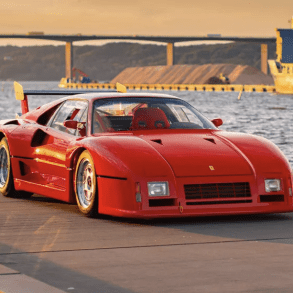
Ferrari 288 GTO Evoluzione
Year: 1987
Engine: 2.9 L Twin-Turbo V8
The Evoluzione, introduced in 1986, was built to race in Group B but when that series was cancelled the project was also shelved as it was not fit for any other racing series. Ferrari had planned a production run of 20 cars to comply with Group B homologation requirements for Evolution models. Powered by an upgraded version of the 2.9 L twin-turbo V8 in the 288 GTO. Learn More
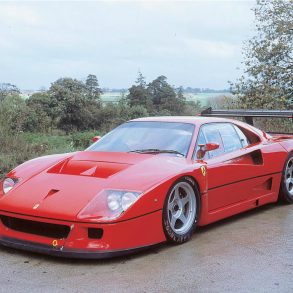
Ferrari F40 Competizione
Year: 1989
Engine: 2.9 L Twin-Turbo V8
The F40 Competizione is a non-sponsored, more powerful version of the F40 LM, which was the result of consumer requests following the order of a French importer who wanted to enter one in the 24 Hours of Le Mans. 10 examples were built, all at customer request, the first two being called F40 LM's, and the remaining 8 being F40 Competizione. Learn More
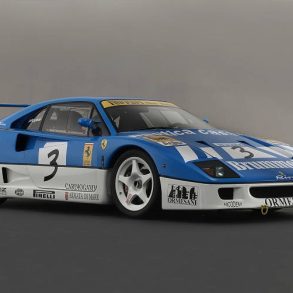
Ferrari F40 CSAI-GT
Year: 1993
Engine: 2.9 L Twin-Turbo V8
There were only 7 F40 GTs built. All were built by Michelotto in 1993 and described as F40 CSAI-GT cars. All featured 590 hp, Brembo brakes, lighter carbon fiber bodies [1050 kg], a racing uni-ball suCSAI-GT ension, quick fill fuel system, flat fours with cooling ducts for the engine, rear brakes and transmission, a fire system; plexi glass sliding windows. Learn More
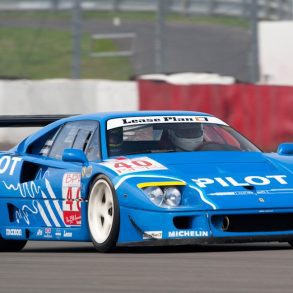
Ferrari F40 LM
Year: 1989
Engine: 2.9 L Twin-Turbo V8
This race-spec variant packs more power, better aerodynamics and less weight than the car it is based on. The LM, which stands for Le Mans, was specced to satisfy IMSA regulations with the goal of competing on the world’s highest stage in its performance category. In the end, only 19 Ferrari F40 LM examples were produced. Learn More
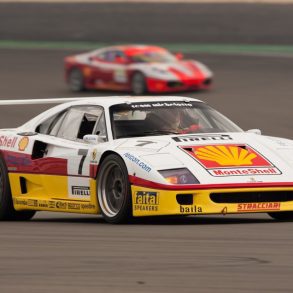
Ferrari F40 GT
Year: 1993
Engine: 2.9 L Twin-Turbo V8
F40 GTs were sent by the factory to Michelotti. The F40 GT is not as crazy as the LM, but that was done so it could compete in the Italian GT Championship. The body was lighter and 17 inch magnesium wheels, bigger brakes, a race exhaust and a better cooling system were added. The upgraded engine produced 560 bhp instead of the standard 478 bhp. Learn More
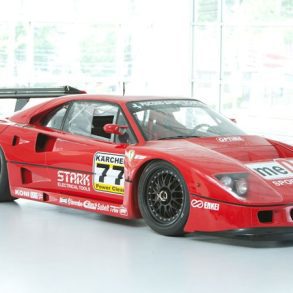
Ferrari F40 GTE
Year: 1995
Engine: 2.9 L Twin-Turbo V8
The Ferrari F40 GTE was used from 1995 till 1997. It still raced in the GT1 class in BPR and Le Mans. The F40 GT proved to be a good racing car, so Michelotto converted seven more F40’s for the BPR Global GT Series. These cars were called the F40 GTE. One of them started life as an LM, one of them as a GT and the rest as road cars. An evolution of the LM with 620 bhp. Learn More
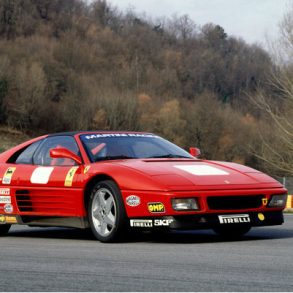
Ferrari 348 GT Competizione
Year: 1994
Engine: 3.4 L V8
Produced by Ferrari’s Assistenza Clienti department, the Ferrari Daytona was produced in 1971 to Group 4 specification for limited clients. During the inaugural year, only 5 of these cars were produced with aluminum body panels, plexiglass windows and a cold air induction that raised power to 402 bhp. Learn More

Ferrari 348 GT LM
Year: 1994
Engine: 3.4 L V8
Michelotto built a further 2 cars in 1994, designated as 348 GTC-LM for competition within the GT2 class, campaigned by Team Repsol and Ferrari Club Italia. Team Repsol placed 4th in the GT2 class for the 1994 24 Hours of Le Mans, following a trio of Porsche 911 GTs, and 11th overall. Learn More
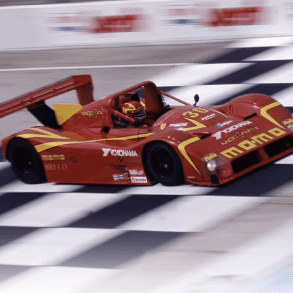
Ferrari F333 SP
Year: 1994
Engine: 4.0 L F310E V12
After a 20 year absence from sports prototype racing, Ferrari revealed the F333 SP as part of their successful return. Built initially to run IMSA’s Exxon World Sports Car Championship in 1994, many called it an F1 car with two seats and full bodywork. Intended for private teams, the F333 was also quite successful—winning 12 Hours of Sebring and Daytona 24 Hours and more. Learn More
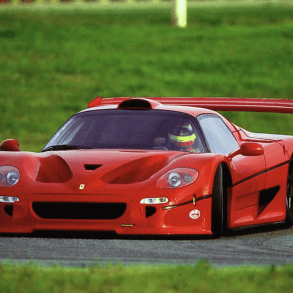
Ferrari F50 GT
Year: 1996
Engine: 4.7 L V12
With good aerodynamics and braking to complement its stiff chassis design, and having the necessary production figures to meet homologation requirements, it seemed only fitting for the F50 to continue the legacy of the F40 GTE. That is, contest the BPR Global GT Endurance Series, a precursor to FIA GT. Not surprisingly, Ferrari flirted with this idea and began a development of the F50 GT. Learn More
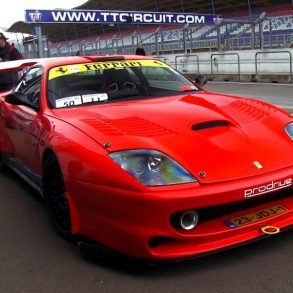
Ferrari 550 GT/GTS
Year: 2001
Engine: V12
Prodrive extensively worked on the 550, transforming it into a machine that we might see run the AMLS, European Lemans Series and the 24 Hours of Lemans. Much work was done to reduce weight with most of the savings coming from new carbon fibre bodywork. There was also a separate 550 GTS (not related) built by German entrepreneur Franz Wieth and Baumgartner Sportwagen Technik. Learn More
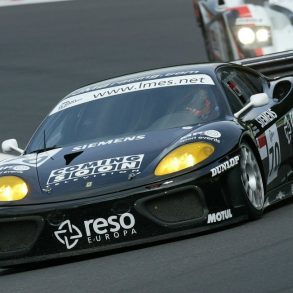
Ferrari 360 GT
Year: 2002
Engine: V8
The history of the 360 GT begins with Team JMB Giesse who created a modified challenge car to race in the 2000 FIA N-GT Championship. It wasn't official though. Ferrari then got motivated to move forward with 360 GT production. In February of 2002, Ferrari announced they would sell 360 GTs through their Corse Clienti Department. Michelotto again worked on it, and it raced in 2002 onward. Learn More
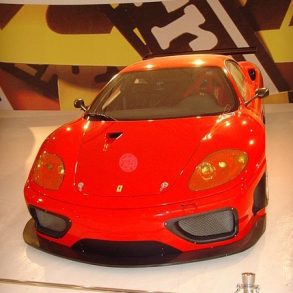
Ferrari 360 N-GT
Year: 2002
Engine: V8
Also known as the 360 Michelotto. The Ferrari 360 N-GT was a 360 Challenge race car tuned by Michellotto for the N-GT category of the FIA GT Championship. It was the fastest version of the Ferrari 360 with the engine generating a power output of over 547 PS (402 kW; 540 hp) when derestricted. It was the final car built through a Ferrari-Michelotto collab. Learn More
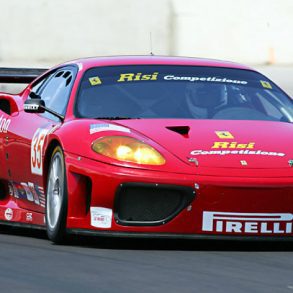
Ferrari 360 GTC
Year: 2004
Engine: V8
Ferrari have introduced a race version of the Challenge Stradale to counter the threat posed by Porsche’s new 996GT3 RSR in GT racing. The new model, to be called the 360GTC, receives a similar acronym to its recently introduced big sister, the 575GTC. The Ferrari 360 GTC has been developed to replace the previous 360 GT and was available to race in 2004. Learn More
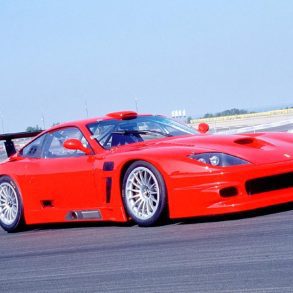
Ferrari 575 GTC
Year: 2004
Engine: 6.0 L V12
Following on from the success of privately-entered 550 Maranellos in international GT racing, including a historic class win in the 2003 Le Mans 24 Hours, Ferrari has developed its own in-house evolution of the new 575M Maranello, the 575 GTC (where the C stands for Competizione). Developed specifically for the FIA GT and GrandAm championships. Learn More
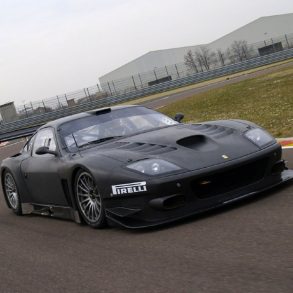
Ferrari 575 GTC Evo
Year: 2005
Engine: 6.0 L V12
The Ferrari Corse Clienti department made changes to the original version. The aero was completely revised with the addition of a new splitter and air intake on the new bonnet. These changes improve internal air flow. The engine was totally redesigned and, together with the new cooling tank, resulted in greater power and better handling on track. Learn More
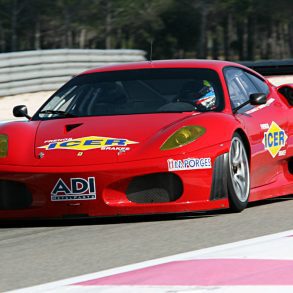
Ferrari F430 GTC
Year: 2006
Engine: 4.0 L V8
The F430 GT is a stripped down version of the road car meant for endurance racing. It has been used in many road-race series including FIA GT2, ALMS, International Open GT and Italian GT events. The F430 GT's major debut was at the 12 Hours of Sebring where Risi Competizione took third overall. It was a resounding success for an 'out of the box' racer. Learn More
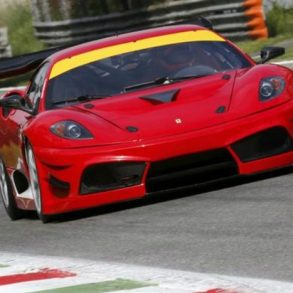
Ferrari F430 GT3
Year: 2006
Engine: V8
A GT3-version of the F430 GT emerged for the FIA GT3 season. Originally based on the F430 Challenge, the F430 GT3 was a specialized racing car developed by JMB Racing for the FIA GT3 Euro Championship and other national GT championships such as British GT and FFSA GT. Mechanically similar to the F430 Challenge but with better aero and more power. Learn More
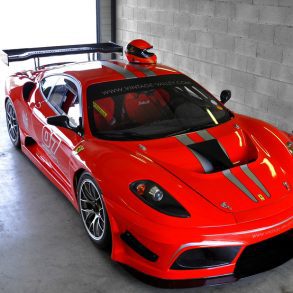
Ferrari Scuderia GT3
Year: 2009
Engine: V8
For the 2009 season Kessel Racing developed a successor to the successful 430 GT3. Based on the Scuderia, the new car is faster than the F430 GT which won the 2007 FIA GT3 European Championship. The Scuderia is based on the road car and modified as much as the FIA GT3 rules will allow. Learn More
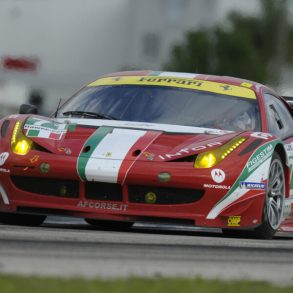
Ferrari 458 Italia GT2
Year: 2011
Engine: V8
Ferrari unveiled their new GTE class racer in 2011 to take part in Championships sanctioned by ACO and FIA. The 458 Italia GT2 drops the "flex splitter" found in the road cars in favor of a more conventional inlet, with the air exiting out through the louvers in the bonnet. Under new restrictor regulations, the 4.5-litre V8 engine generates less power than the production car. Learn More
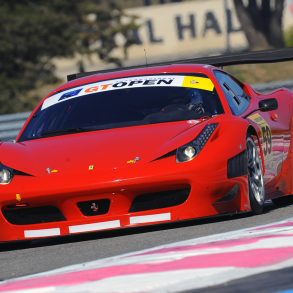
Ferrari 458 Italia GT3
Year: 2012
Engine: V8
For the popular GT3-spec racing Ferrari had Michelotto Automobili prepare a version of their 458. In 2011 the car made appearances at the FIA GT3 Championship, AsiaGT, Italian GT and ADAC GT. In 2011 the most prestigious event for GT3 was the 2011 Total 24 Hours of Spa which had seven Ferrari 458 GT3s. The highest placing Ferrari placed 5th overall. Learn More
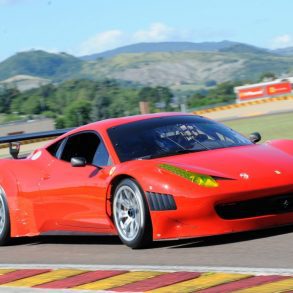
Ferrari 458 Grand-Am
Year: 2012
Engine: V8
In 2012, Ferrari developed a modified version of the 458 GT3 for Grand-Am. The car weighs the same but produces less downforce than the GT3 car; the engine is also restricted more heavily, generating a power output of 500 hp and having an 8,000 rpm redline. Instead of a dual-clutch it gets a conventional sequential manual. Learn More
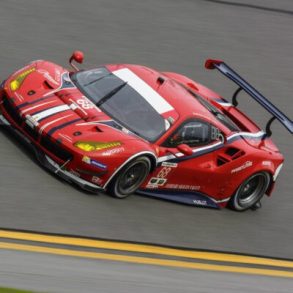
Ferrari 488 GTE
Year: 2016
Engine: V8
The 3.9-liter twin-turbo V8 replaced the 4.5-liter V8 in the road-going version, and carried over to the race track as well. The turbocharged versions made their debut at January’s Rolex 24 at Daytona. Presented over the weekend at Mugello, the lineup included both GTE and GT3 racers to replace the current models that were based on the 458 Italia. Learn More
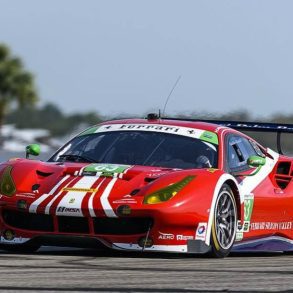
Ferrari 488 GT3
Year: 2016
Engine: V8
Ferrari has officially unveiled its 488 GTE and GT3 cars together at the Ferrari Finali Mondiali and they will debut in GT competition worldwide in 2016. Both versions are nearly identical to each other, with the GTE version featuring a race-prepped 3.9-liter twin-turbocharged V8 engine, compared to a production-based unit (same displacement) in the GT3 challenger. Learn More
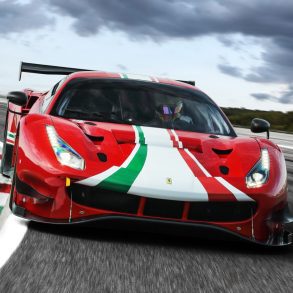
Ferrari 488 GT3 EVO
Year: 2020
Engine: V8
The Ferrari 488 GT3 Evo gets aerodynamics, dynamics, ergonomics, safety, and reliability updates. The car has a longer wheelbase, a front end revised so that it cools things better and provides better downforce, and a lighter-weight seat. Those are only the highlights. The engine is still the same twin-turbo V8 but it gets a new system to manage torque and power. Learn More
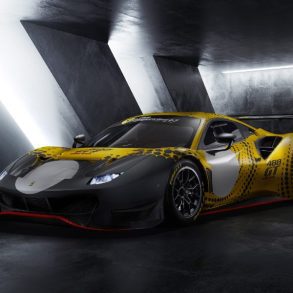
Ferrari 488 GT Modificata
Year: 2021
Engine: V8
A limited-edition model that blends together technology developed for the 488 GT3 and the 488 GTE. This car is designed specifically for track days and at Ferrari Club Competizioni GT events. The car utilizes a twin-turbo V8 engine that puts out 700 hp. This is more than the GT3 and the GTE. There’s also an updated transmission. Learn More
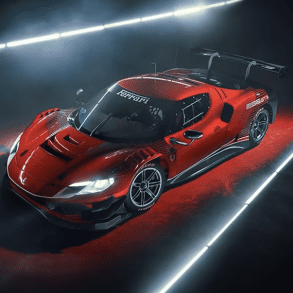
Ferrari 296 GT3
Year: 2023
Engine: 2.9L Twin-Turbo V6
Taking the 296 GTB's performance to the track, the 296 GT3 is a purpose-built racing machine designed to compete in GT3 championships worldwide. It features a modified version of the 296 GTB's V6 engine, tuned for racing and delivering increased power and durability. The GT3's aerodynamics have been extensively refined. Learn More
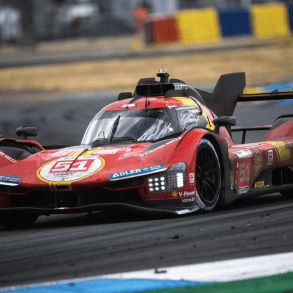
Ferrari 499P
Year: 2023
Engine: ff
The Ferrari 499P is a Le Mans Hypercar (LMH) that signifies Ferrari's grand return to the top tier of endurance racing after a 50-year hiatus. It made its debut in the 2023 FIA World Endurance Championship. Not only did the 499P prove to be incredibly fast, but it also demonstrated exceptional reliability, culminating in a historic victory at the 2023 24 Hours of Le Mans.


